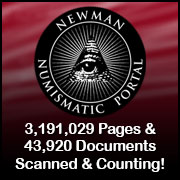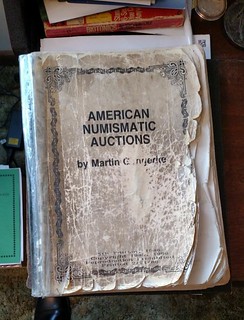
About UsThe Numismatic Bibliomania Society is a non-profit association devoted to the study and enjoyment of numismatic literature. For more information please see our web site at coinbooks.org SubscriptionsThose wishing to become new E-Sylum subscribers (or wishing to Unsubscribe) can go to the following web page link MembershipThere is a membership application available on the web site Membership Application To join, print the application and return it with your check to the address printed on the application. Print/Digital membership is $40 to addresses in the U.S., and $60 elsewhere. A digital-only membership is available for $25. For those without web access, write to: Charles Heck, Treasurer AsylumFor Asylum mailing address changes and other membership questions, contact Chuck at this email address: treasurer@coinbooks.org SubmissionsTo submit items for publication in The E-Sylum, write to the Editor at this address: whomren@gmail.com
BUY THE BOOK BEFORE THE COIN |
- WAYNE'S WORDS: THE E-SYLUM DECEMBER 27, 2020
- NEW BOOK: THE COINS OF CANADA 39TH EDITION
- NEW BOOK: ENGLISH SILVER COINAGE 7TH EDITION
- NEW BOOK: ENGLISH GOLD COINAGE 1649-1816
- NEW BOOK: CATALOG OF BELGIAN NUMISMATIC ISSUES
- NEW BOOK: PAPER MONEY GERMAN SOUTH WEST AFRICA
- NEW BOOK: 2020 CANADIAN TIRE CATALOGUE
- PERIODICAL: NUMISMATIQUE ASIATIQUE NO. 36
- U.S. GRANT MEDAL STRUCK ON 1000 TONS PRESS
- VIDEO: HIGHFILL SILVER DOLLAR ENCYCLOPEDIA
- MORE ON MARTIN GENGERKE
- MORE ON THE BIG MAPLE LEAF COIN
- NOTES FROM E-SYLUM READERS: DECEMBER 27, 2020
- VOCABULARY TERM: COIN COUNTER
- WILLIAM PRESTON BEAVER (1865-1927)
- JULIUS DREIFUS AND THE 1804 DOLLAR
- THE 2021 ANS GALA
- TREASURY CHOOSES NEW QUARTER REVERSE DESIGN
- SENATE BILL WOULD RESTRICT TRADING OF MEDALS
- DAVISSON'S E-AUCTION 38 SELECTIONS
- WORLD BANKNOTE AUCTIONS SALE 1 HIGHLIGHTS
- CELTIC GOLD COIN HOARD UNCOVERED
- MEDIEVAL COIN HOARD FOUND IN POLAND
- LEXINGTON PIG PENNY ELONGATED CENTS
- RUSSIAN-AMERICAN WALRUS SKIN NOTE
- THE DARDANELLES OVERPRINTS
- ACTF FLAGS ONLINE COIN REPLICA SELLER
- VIDEO: MAKING COINS INTO JEWELLERY
- ALTERNATIVE CURRENCY IN THE COVID ERA
- VENEZUELAN RUNESCAPE GAMERS PLAY TO SURVIVE
- CAPE COD TREASURE HUNT'S CHEST OF SACAGAWEAS
- FEATURED WEB SITE: VICTOR HUSTER MINT
Content presented in The E-Sylum is not necessarily researched or independently fact-checked, and views expressed do not necessarily represent those of the Numismatic Bibliomania Society.
WAYNE'S WORDS: THE E-SYLUM DECEMBER 27, 2020
 New subscribers this week include:
Alex M.
Welcome aboard! We now have 6,603 subscribers.
New subscribers this week include:
Alex M.
Welcome aboard! We now have 6,603 subscribers.
Martin Kaplan writes:
"My wish is that next year on this date you’ll report... We now have 10,000 subscribers."
Great thought as we head into the new year. We clawed and inched our way to the present level mostly on word of mouth - individual readers telling their friends about us and signing them up. Some find our site as the result of a web search and sign up. Once in a while someone invites their whole local club along.
To get to 10,000 in just a year we'll need some big helpers. Some of our best surges have come when dealers publish a note in their newsletter or add a link to us on their website. Can you help? If you're a dealer or just a well-connected hobbyist with a lot of numismatic friends, please contact me and we'll discuss options for bringing people onboard. The simplest is to just sign them up; once people are on board, they rarely unsubscribe, but they can do that at any time if they decide The E-Sylum is not for them. Our coverage is broad though, and most people find something of interest in nearly every issue.
Thank you for promoting The E-Sylum and bringing more voices into the mix. Contact me at whomren@gmail.com anytime about connecting your friends and clients to one of the best hangouts for smart and engaged numismatists.
This week we open with six new books, a periodical, updates from the Newman Numismatic Portal, and more.
Other topics this week include the U.S. Grant medal, the Big Maple Leaf, coin counting boards, Julius Dreifus and the 1804 dollar, the ANS Gala, the new quarter designs, auction highlights, coin hoards, Walrus skin notes, fake coins, alternative currency, and the Huster mint.
To learn more about English silver and gold coinage, Belgian numismatics, Canadian Tire money, the 1,000-ton medal press, the Comprehensive U.S. Silver Dollar Encyclopedia, Martin Gengerke's hobby contributions, when Baby Doc left Haiti, Banjo Paterson, William Preston Beaver, the new “Washington Crossing the Delaware” quarter, the Bristol Halfcrown, pig pennies, the Dardanelles overprints, Berkshares, and the Sacagawea dollar treasure chest, read on. Have a great week, everyone!
Wayne Homren
Editor, The E-Sylum

NEW BOOK: THE COINS OF CANADA 39TH EDITION
The new edition of The Coins of Canada is now available. -Editor
The Coins of Canada – 39th edition
$29.95
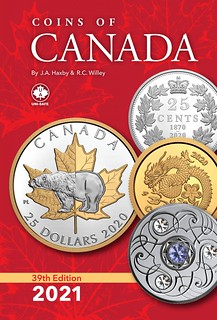 The 39th edition of The Coins of Canada is a complete, one-volume library of Canadian coins, tokens and paper money, including major varieties. Available in English and French.
The 39th edition of The Coins of Canada is a complete, one-volume library of Canadian coins, tokens and paper money, including major varieties. Available in English and French.
Features:
- Complete Canadian decimal coinage
- Pre-Confederation Provincial issues
- All Canadian Mint silver and gold collector’s issues
- Canadian colonial tokens
- Dominion of Canada banknotes 1867-1935
- Bank of Canada paper money 1935 to date
- Latest retail market values by grade
- Detailed mintage figures and statistics
- Much historical background and pertinent information
- Condition Grading Guides for Canadian coins
- Includes a glossary of numismatic terms
For more information, or to order, see:
The Coins of Canada – 39th edition; available in English and French.
(https://coinstampsupplies.com/product/the-coins-of-canada-39th-edition-available-in-english-and-french-pre-order-now/)

NEW BOOK: ENGLISH SILVER COINAGE 7TH EDITION
SPINK has published a new edition of English Silver Coinage. -Editor
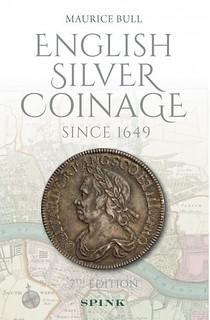 English Silver Coinage Since 1649 7th Edition
English Silver Coinage Since 1649 7th Edition
Maurice Bull
£50.00
Hardback
216 x 138 mm
680 pages with colour illustrations throughout
ISBN: 978--1-912667-49-9
This new 7th edition offers an update to Maurice Bull's previous volume, with new varieties, corrections and current prices. The arrangement is again done by monarch rather than denomination, and all Bull reference numbers are cross-referenced to the 5th edition.
The section on Provenances lists the instances of illustrations of coins and where they have appeared, potentially proving the existence of many rare examples or those only rumoured to exist. Rarity of the coins has again been looked at in light of current evidence.
English Silver Coinage is a record of the major and many minor recognised types and die-varieties of English silver coins. This indispensible guide is truly the essential handbook for any collector of English silver coinage.
For more information, or to order, see:
English Silver Coinage Since 1649 7th Edition Maurice Bull
(http://www.spinkbooks.com/index.php?route=product/product&path=59/&product_id=762)
NEW BOOK: ENGLISH GOLD COINAGE 1649-1816
SPINK has published a new comprehensive guide to English gold coinage. -Editor
English Gold Coinage 1649-1816
Maurice Bull
£50.00
Hardback
216 x 138 mm
312 pages with colour illustrations throughout
ISBN: 978-1-912667-50-5
This brand new comprehensive guide covers every type of English gold coin and includes many new varieties, along with current prices. The arrangement is by monarch, with accompanying Bull reference numbers cross-referenced to the Standard Catalogue of British Coins.
The section on Provenances lists the instances of illustrations of coins and where they have appeared, potentially proving the existence of many rare examples or those only rumoured to exist. Rarity of the coins has also been looked at in light of current evidence.
English Gold Coinage is a record of the major and many minor recognised types and die-varieties of English gold coins. This indispensible guide is truly the essential handbook for any collector of English gold coinage.
For more information, or to order, see:
English Gold Coinage 1649-1816 Maurice Bull
(http://www.spinkbooks.com/index.php?route=product/product&path=59/&product_id=763)
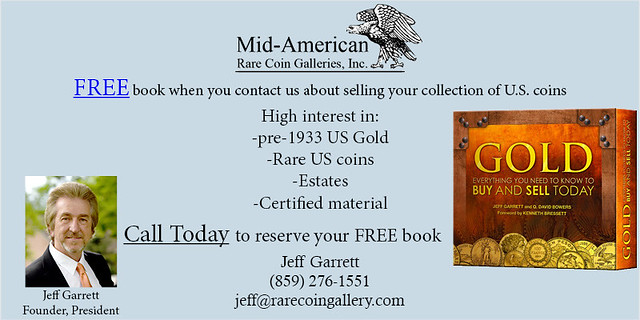
NEW BOOK: CATALOG OF BELGIAN NUMISMATIC ISSUES
Laurens Aernout has published a new catalog of Belgian numismatics. Here's a Google-translated version of the book's description. -Editor
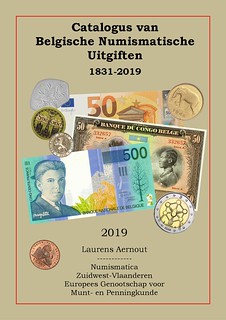 The catalog CBNU - Edition 2019 !!!
The catalog CBNU - Edition 2019 !!!
Contents: the coins, notes and sets of the Belgian franc as well as the euro. This also includes the Belgian ECU coins, tokens and sets, together with the commemorative medals, the local issues and notes of the Belgian army, the coins and notes of the Congo Free State, the Belgian Congo and the mandate areas. New in this edition are the tax plates of the Belgian Congo!
All this with updated prices and with new variants, in words and pictures! Main language Dutch with French and English Lexicon.
Features: 720 pages, black / white, 17cm high x 12cm wide x 3cm thick, 750gr +, ISBN 9789082449020
Price: 15EUR
The catalog is available via ebay, the post, at your local coin club, at the Standaardboehandel, at your local coin shop, etc.!
For more information, or to order, see:
http://www.cbnu.be/home/
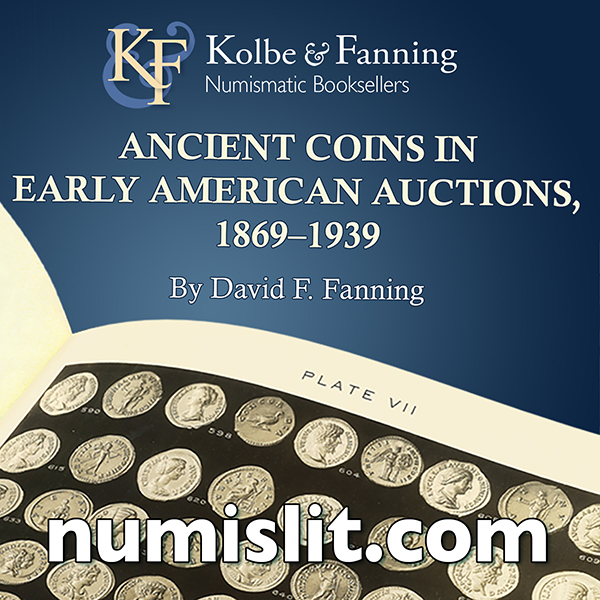
NEW BOOK: PAPER MONEY GERMAN SOUTH WEST AFRICA
This isn't a new book, but it's new to me and worth mentioning here. In our Zoom meeting last week, my friend and fellow Nummis Nova member Eric Schena displayed some South African emergency paper money of the second Anglo-Boer War. He mentioned this book as his reference. It was published in 2015, but unfortunately is already out of print. I found listings on Amazon and elsewhere, but no one seems to actually have one in stock. Never hesitate to buy a numismatic book of interest - it could soon be unavailable at any price. -Editor
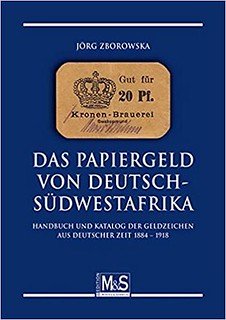 The paper money of German South West Africa: manual and catalog of the money signs from the German period 1884-1918
The paper money of German South West Africa: manual and catalog of the money signs from the German period 1884-1918
By Jörg Zborowska
format Paperback | 116 pages
Dimensions 146 x 211 x 10mm | 180g
Publication date 13 Jul 2015
Publisher Battenberg Gietl Publishing House
Language German
Edition statement 1st ed.
Illustration note m. numerous color fig.
ISBN10 3866468482
ISBN13 9783866468481
After Arnold Keller presented a comprehensive treatment of the topic for the last time in the 1960s, this book is a more extensive work based on the latest research results. The introduction explains historical connections. In particular, the problems of supplying the economy with means of payment caused by the First World War are discussed.
The author has understood how to shed light on the jungle of different means of payment and to systematically record numerous, in some cases previously unknown, issues of private vouchers. For this purpose, the author made several trips to Namibia, the former German South West Africa, to view museum holdings and to collect information. In the catalog part there is a clear compilation of the voucher types with current ratings.
For more information, see:
The paper money of German South West Africa: manual and catalog of the money signs from the German period 1884-1918
(https://www.bookdepository.com/Das-Papiergeld-von-Deutsch-S%C3%BCdwestafrika-J%C3%B6rg-Zborowska/9783866468481)
Das Papiergeld von Deutsch-Südwestafrika: Handbuch und Katalog der Geldzeichen aus deutscher Zeit 1884 - 1918
(https://www.amazon.com/Das-Papiergeld-von-Deutsch-S%C3%BCdwestafrika/dp/3866468482)
Eric Schena adds:
"It’s a fascinating subject; there’s not a lot numismatically from there and even less so after the German period. At that point up until Namibia’s independence in 1993, most of the money that circulated was South African supplemented by fairly limited issues of private bank notes from the Standard Bank of South Africa, Volkskas, and Barclays Bank DCO (Dominion, Colonial, and Overseas). The book is in full color and even a non-German speaker will find it useful, though of course some vocabulary is definitely recommended to get more in-depth. I was very lucky to find the copy I did. I need to see if there are similar works on German East Africa."
To read the earlier E-Sylum article, see:
ERIC'S SCHENA'S MARSHALL HOLE NOTES
(https://www.coinbooks.org/v23/esylum_v23n51a23.html)
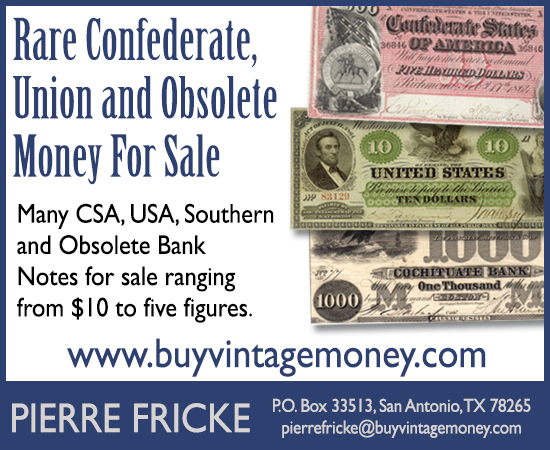
NEW BOOK: 2020 CANADIAN TIRE CATALOGUE
The Canadian Tire Coupon Collectors Club has published a new edition of their catalog of Canadian Tire Money and associated coupons. -Editor
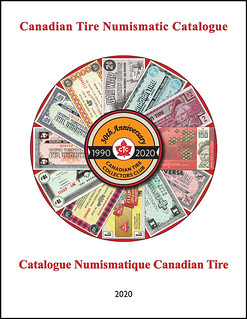 2020 Canadian Tire Numismatic Catalogue
2020 Canadian Tire Numismatic Catalogue
The 2020 Canadian Tire Numismatic Catalogue contains all the regular issues of notes issued by the Corporation, the Petroleum division and Simard-Montcalm. The large majority are made by Canadian Banknote Company and British American Bank Note. This new edition is a complete renewal and now includes over 1200 Canadian Tire numismatic items.
The catalogue numbers have been upgraded to facilitate electronic sorting with as little impact as possible on the original numbering system. All major varieties have been added. If you have a major variety that is missing let us know and we will get it into next years revision.
All notes issued until the end of December 2019 are included.
There are nearly 1000 images describing the notes. This catalogue is in color and the format is 8.5” x 11” and has 140 pages.
Due to a change in the printing process, the catalogue is now available in full colour at a reasonable price.
For more information, or to order, see:
2020 Canadian Tire Numismatic Catalogue
(https://coinstampsupplies.com/product/2020-canadian-tire-numismatic-catalogue/)
2020 Canadian Tire Numismatic Catalogue – Downloadable
(https://ctccollector.ca/store/shop/2020-canadian-tire-numismatic-catalogue-downloadable/)
PERIODICAL: NUMISMATIQUE ASIATIQUE NO. 36
Here are the contents of the latest issue of Numismatique Asiatique. -Editor
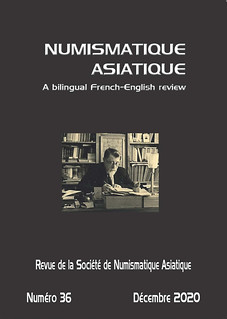 Editorial :
Editorial :
About the inalienability of public collections
JAPAN :
Japanese Collectors a Century Ago
by Craig Greenbaum
CAMBODGE :
Note à propos des inscriptions khmères, siamoises et chinoises figurant sur les monnaies et jetons de Norodom
par Olivier de Bernon
ANNAM :
La collection de monnaies annamites du Dr. Albert Sallet
par François Joyaux
EXTREME-ORIENT :
Les collections de monnaies asiatiques du Musée de La Cour d'Or-Metz Métropole : redécouverte et mise en perspective
par Bluenn Boulangé, Bruno Jané et Kévin-Alexandre Kazek
Les collections numismatiques de la Fondation Calvet (Avignon). Catalogue des monnaies d'Extrême-Orient. par Marie-Laure Le Brazidec
INDOCHINE :
Le projet de 2 cents 1937 d'Indochine
par Laurent Bonneau
Médaille du paquebot Paul Lecat pour l'Indo-Chine par Daniel Cariou
BIBLIOGRAPHIE :
Cast Chinese Amulets, de David Hartill
Série "Monnaies d'Asie"
For more information, or to order, see:
https://sites.google.com/site/societedenumismatiqueasiatique/revue
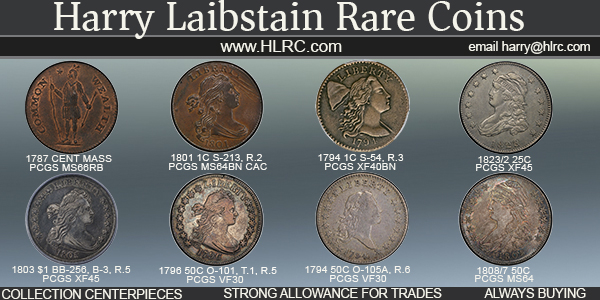
U.S. GRANT MEDAL STRUCK ON 1000 TONS PRESS
Newman Numismatic Portal Project Coordinator Len Augsburger provided the following report relating to a massive U.S. Mint medal. -Editor
U.S. Grant Medal (MI-29) Struck on 1000 Tons Medal Press
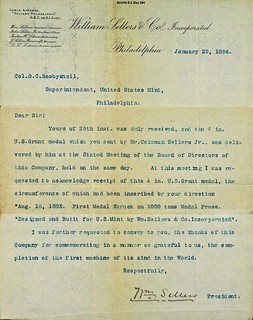 User ”messydesk” posted on the PCGS U.S. Coin Forum an interesting 1894 letter from the National Archives, processed by Newman Portal, acknowledging receipt of a U.S. Grant medal from the Philadelphia Mint. The medal, Julian MI-29, was a massive production weighing in at 28.77 ounces (the gold example, struck in 1865), and measuring 105 mm. The letter, written by William Sellers, notes that an example of this medal (presumably bronze, though not specifically stated) had been struck on a new press and inscribed on the edge accordingly.
User ”messydesk” posted on the PCGS U.S. Coin Forum an interesting 1894 letter from the National Archives, processed by Newman Portal, acknowledging receipt of a U.S. Grant medal from the Philadelphia Mint. The medal, Julian MI-29, was a massive production weighing in at 28.77 ounces (the gold example, struck in 1865), and measuring 105 mm. The letter, written by William Sellers, notes that an example of this medal (presumably bronze, though not specifically stated) had been struck on a new press and inscribed on the edge accordingly.
Does the medal still exist today? Robert Hoge, ANS Curator Emeritus, responded “Coleman Sellers Jr. was my great-great-grandfather. Prominent engineers and industrialists, he and William Sellers were cousins who seem to have worked frequently together. I have no idea as to what became of that particular U.S. Grant medal, I’m sorry to relate. Both William and Coleman would have received quite a few award medals during their careers, but I have no knowledge of what happened to any of those either. In fact, alas, I myself possess only a couple of Sellers family related mementoes of any kind and am not aware of the whereabouts of much else.”
The gold example is today in the National Numismatic Collection, and the massive format was not an outlier. The Cyrus Field gold medal (PE-10) is just under 25 ounces, while the Henry Clay medal (PE-7) is nearly 30 ounces. The Field medal, now in the Weinberg collection, will be featured in the upcoming Heritage FUN sale.
Link to National Archives content on Newman Portal:
https://nnp.wustl.edu/Library/Archives?searchLetter=U
Link to Field gold medal, PE-10, offered by Heritage Auctions:
https://coins.ha.com/itm/medals-and-tokens/tokens-and-medals/1867-cyrus-w-field-congressional-gold-medal-julian-pe-10-ms62-ngc/a/1326-4156.s?ic4=ListView-ShortDescription-071515
THE BOOK BAZARRE
VIDEO: HIGHFILL SILVER DOLLAR ENCYCLOPEDIA
These are selections from the David Lisot Video Library that feature news and personalities from the world of coin collecting. David has been attending coin conventions since 1972 and began videotaping in 1985. The Newman Numismatic Portal now lists all David’s videos on their website at:
https://nnp.wustl.edu/library/multimediadetail/522852
Here's one on the creation of Highfill's Comprehensive U.S. Silver Dollar Encyclopedia. -Editor
Creation of the “Comprehensive U.S. Silver Dollar Encyclopedia” June 1, 2016.
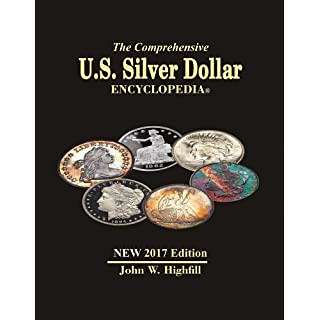 John Highfill, Publisher and Author,
John Highfill, Publisher and Author,
Interviewer, David Lisot, CoinTelevision.com.
John Highfill created one of the largest books on silver dollars ever. He contacted experts in the numismatic industry to contribute making it truly the most “comprehensive” sources of information imaginable. John shares how much work was involved in the process of having the book published and how he enlisted Walter Breen to act as his editor.
An excerpt of the video is available for viewing on the Coin Television YouTube Channel at:
https://youtu.be/F-4LjvkkMs0

MORE ON MARTIN GENGERKE
Anthony Terranova of New York City writes:
"Greatly saddened to hear about my friend Martin. We will miss his wisdom."
Mike Hodder submitted these notes on Martin and his impact on numismatic publishing and cataloging. Thanks! I added an image of Martin circa 1993 at his desk in the Coin Galleries office courtesy of George Cuhaj, who worked there from 1990 to mid-1994. -Editor
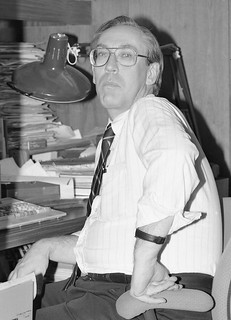 I met Martin Gengerke when I started working for Stack’s as a cataloguer in 1991 (I think). Martin’s desk was upstairs in the Coin Galleries suite in a small passway between the shipping department and the classical numismatics cataloguer’s desk (Jan Blamberg). Martin sat facing one wall while opposite him George Cuhaj sat facing the other. It was always tight for space in there.
I met Martin Gengerke when I started working for Stack’s as a cataloguer in 1991 (I think). Martin’s desk was upstairs in the Coin Galleries suite in a small passway between the shipping department and the classical numismatics cataloguer’s desk (Jan Blamberg). Martin sat facing one wall while opposite him George Cuhaj sat facing the other. It was always tight for space in there.
Martin was Stack’s computer maven. He had brought the firm into modern times by introducing into its cataloguing methods the software then being used by the NY Times. This was a word processing program named XyWrite III+ that ran on DOS (I think the flavour was MS-DOS). It was entirely keyboard driven requiring memorization of Control and Alt key combinations and the use of other unintuitive commands to indicate bold or Italic text. Martin loved the software; he once told me he thought a mouse was a lazy man’s input device.
Stack’s cataloguing procedure at the time I started there was a combination of the traditional 1940’s-50’s method with hints of the technology to come that would revolutionize the whole thing. Descriptions were written by hand on the face of No.6 envelopes along with the consignor’s identification letter and a note of what sale the lot was to go into. The coin or medal, itself, was enclosed in the envelope to allow for later grade and attribution checks as needed. White envelopes were used for regular Stack’s floor bid sales, green ones for Coin Galleries’ mail bid sales. Martin and George transcribed the handwritten descriptions into XyWrite III+ and saved their work onto floppies at the end of the day. Martin’s job at cataloguing deadline was to arrange all the descriptions into agreed on sale order, control fonts and type sizes, and oversee the transfer of files from XyWrite III+ into the format used by the firm that printed and bound Stack’s catalogues.
When I knew him, Martin seemed a very private person. His knowledge of fractional currency seemed formidable to me. His catalogue of American auction catalogues was one of the handful of reference works I always used in my work. A cryptic note on a consignor’s inventory like “Bt. at sale 5/81” would lead first to Martin’s list to see if an auction had taken place that month and then to identify the sale and company, then a visit to Stack’s comprehensive library to hunt down that sale catalogue, then to possible candidates for an identification and if I was lucky, a precise description or a plate of the coin to seal the provenance. I’ve sold or given away most of my numismatic library but I’ve hung onto my bound copy of Martin’s American Numismatic Auctions for old time’s sake.
Mike Hodder
December, 2020
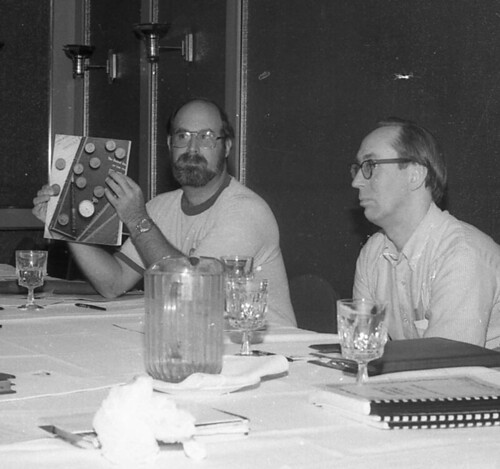
Peter Huntoon shared these thoughts on Martin and his impact on numismatics. Thank you! -Editor
I knew Martin professionally primarily as one of the pioneers in maintaining a census of U. S. large size currency. I was aware that he had assembled and sold a world class collection of U. S. fractional currency. His ownership pedigrees on items in that collection will greatly outlive him, but in my opinion his census work ultimately will define his numismatic legacy.
He recorded all classes of large size U. S. currency and was well advanced when I became aware of him in the 1970s. I don’t know what motivated him along this line, but it certainly made sense for someone working in the numismatic auction business because a census defines rarity, reveals available grades, and, for lore, records pedigrees. Martin compiled all these statistics and paid close attention to pedigrees. He enjoyed ferreting out first appearances of classic items in early major collections or sales, and he tracked items through successive appearances.
Working for Stacks gave him access to significant holdings of key material, which was a major competitive advantage for him. However, Martin did not confine his quest to the numismatic market. He made a major effort to catalog institutional holdings including museums, libraries, governmental agencies, and commercial banks. He realized institutional holdings were where many major rarities were to be found. He got access to and painstakingly recorded the holdings of Federal Reserve Banks, various Treasury agencies, and the Smithsonian Institution.
In the course of this work, he helped uncover unrecorded issues and previously unrecognized varieties. He partnered with noted Federal paper researcher Doug Murray in this effort and together they materially added to listings in the Friedberg catalog. The numbering system in the Friedberg catalog runs chronologically through the various classes of currency, so a new discovery of say a Treasury signature combination or design variety requires insertion, which involves adding a letter suffix to the existing number representing the previously recorded item in the list such as Fr.1166c. Many of the items listed in the Friedberg catalog followed by such a letter are the result of the Gengerke/Murray collaboration.
To maintain a census, one must record everything. Martin digested auction catalogs as fast as they came along, a tedious, time-consuming task that grew burdensome and eventually overwhelming with the explosive growth of paper money collecting and sales in the last three decades of the 20th century. Eventually, he saw the writing on the wall and sought to divest himself of the particularly onerous burden of national bank notes so he could focus on the other Federal large size issues. Around the turn of the century, he negotiated the transfer of his large size national bank note census to Don Kelly, who by then had taken on the John Hickman census and thus had a national bank note census that was eclipsing Martins. Martin’s additions to the Hickman-Kelly census materially expanded the whole and that whole now comprises the core of the National Currency Census operated by Andrew Shiva of well over half a million notes.
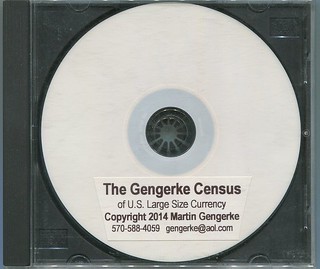 Martin continued to build his census of large size Federal currency but the time demands and his declining health took a toll on his ability to keep up with the onslaught of new material. He distributed the census on a crammed CD that he offered at a nominal price to both people in the trade and collectors. I can tell you that no one makes money on such a venture. When my own research expanded into non-national Federal currency after the turn of the century, Martin generously and without solicitation provided updates. The last update I received is dated 2014, which listed just under 150,000 entries. By then his health was such that it was among the last copies he distributed. It remains the benchmark census because no one has comprehensively compiled such census data for all the Federal issues since. Of course, people track the big-ticket items and new discoveries, but the vast pool of 2nd tier material simply is not getting the attention he gave to it. Regardless, his census did define rarity and that larger perspective remains valid.
Martin continued to build his census of large size Federal currency but the time demands and his declining health took a toll on his ability to keep up with the onslaught of new material. He distributed the census on a crammed CD that he offered at a nominal price to both people in the trade and collectors. I can tell you that no one makes money on such a venture. When my own research expanded into non-national Federal currency after the turn of the century, Martin generously and without solicitation provided updates. The last update I received is dated 2014, which listed just under 150,000 entries. By then his health was such that it was among the last copies he distributed. It remains the benchmark census because no one has comprehensively compiled such census data for all the Federal issues since. Of course, people track the big-ticket items and new discoveries, but the vast pool of 2nd tier material simply is not getting the attention he gave to it. Regardless, his census did define rarity and that larger perspective remains valid.
It is my opinion that Martin’s enduring legacy in numismatics was his role in compiling his census and his devotion to tracing pedigrees during the 20th century. His monetary reward was nil for this activity, it was a true labor of love.
Peter Huntoon
December 2020
Dave Hirt writes:
"Martin did all of us literature collectors a big favor. The information he published never got out of date! It was just there waiting to be looked up!"
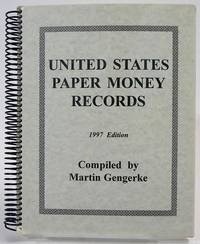
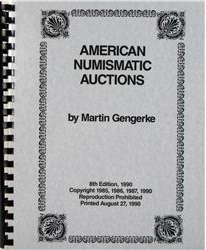
Martin has left an enduring legacy in not one, but TWO numismatic fields: U.S. Paper Money and U.S. Numismatic Literature. We are all better off today as a result of his monumental cataloging efforts. Here's a photo of Dave Hirt's shopworn copy of the Gengerke American Numismatic Auctions book. Thanks, Martin! -Editor
To read the earlier E-Sylum article, see:
MARTIN GENGERKE (1947-2020)
(https://www.coinbooks.org/v23/esylum_v23n51a09.html)
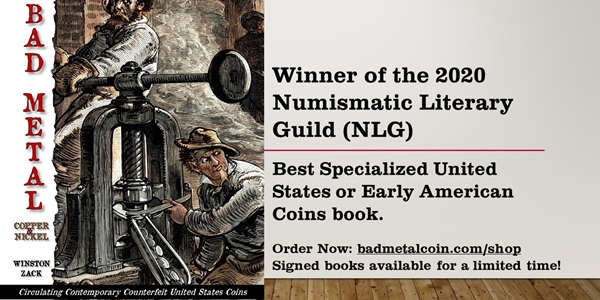
MORE ON THE BIG MAPLE LEAF COIN
John Regitko of Toronto, Canada submitted these notes and photos about the Big Maple Leaf coin. Thanks! -Editor
In the last E-Sylum, you included an item about Canada's $1 million coin. Here are the statistics:
• 100 kilogram; .99999 gold maple leaf $1 million bullion coin
• World’s largest and highest denomination coin ever created at the time, weighing in a 220.5 pounds, 21 inches in diameter, and boasting an unprecedented purity rating of .99999 gold bullion.
• More than $2.1 million in pure gold, it was the most valuable coin ever offered in an online-only auction.
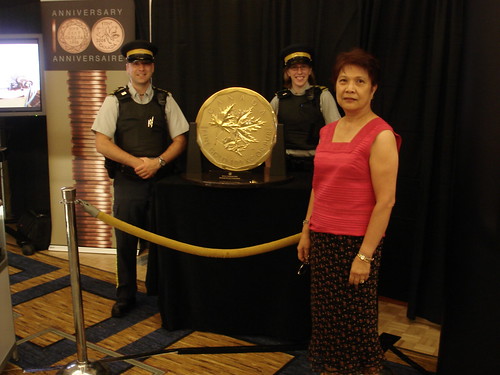
When my wife and I visited the Royal Canadian Mint in Ottawa, I snapped a photo of her beside the coin. This gives you perspective of its actual size (Monina is 5'4"). You will note that two security guards were watching me in case I tried to run away with the coin.
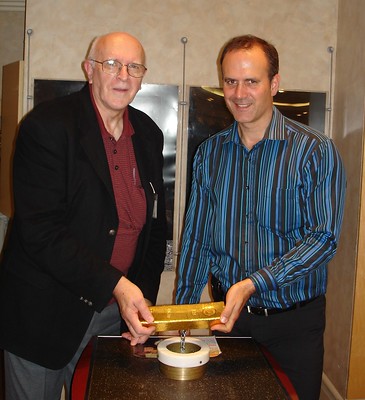 In case anyone is wondering why they would produce such a huge coin, I suspect it was out of concern that when I showed up at the Mint, it would not be necessary to "tie down" all valuables.
In case anyone is wondering why they would produce such a huge coin, I suspect it was out of concern that when I showed up at the Mint, it would not be necessary to "tie down" all valuables.
Although the RCM never acknowledged the reason for the additional security, I think it was because on a previous visit, I tried to walk away with a gold bar worth $600,000 melt value at the time, so they wanted something heavier when I showed up again. My mistake was asking Alex Reeves, RCM Communications Manager, to help carry it out (the evidence is in the photo snapped by a security guard). It weighed 406.55 troy ounces, or nearly 28 pounds. What I didn't realize is that it was fastened down with a metal wire (as can be seen in the photo), I assume due to my impending visit.
To read the earlier E-Sylum article, see:
LOOSE CHANGE: DECEMBER 20, 2020 : Berlin Police Raids in Big Maple Leaf Theft
(https://www.coinbooks.org/v23/esylum_v23n51a35.html)

NOTES FROM E-SYLUM READERS: DECEMBER 27, 2020
World Coin Magazines Offered
Dick Hanscom writes:
"Interests change and storage space must be regained! Just spent the afternoon going through boxes of stuff we moved from the old house.
"I have World Coins magazines, 1964 to 1970 in slip cases, and (11) 1971, (12) 1972, 1973 seems to be missing, (3) 1974, (11) 1975 and (3) 1976. I have also photocopied the indexes for 1964-72 and 1974-75.
"Also, 1975-78 Numismatics International bulletins in NI binders, and (4) empty NI binders. And a few miscellaneous OIN and SIN journals/bulletins.
"All I want is my postage, and a donation from the buyer to the NBS. Postage, even by media mail will be expensive. Total weight is about 60 pounds, probably in two boxes. The recipient will have to tell me how much insurance they would like. Recipient to pay actual postage upon receipt."
Thanks. Who can make good use of these? Dick can be reached at akcoins@mosquitonet.com . -Editor
Retrieving Unique Ancient Aureus Provenance
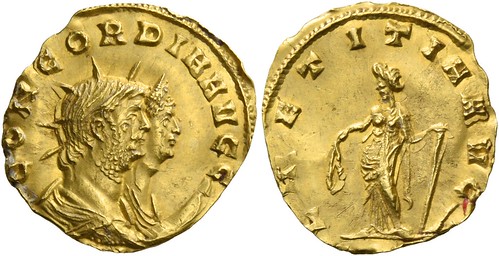
Hadrien Rambach writes:
"Regarding old provenances for Ancient coins, may I mention that this month I published with Jean-Marc Doyen an article entitled “Concordia augg – Deux notes sur un aureus à bustes jumelés de Gallien et Salonine”, in Bulletin du Cercle d’Etudes Numismatiques, vol. 57 (September – December 2020), pp. 12-21. This text, partly in French and partly in English, has the following abstract: Archive research has allowed to retrieve the long pedigree of a unique gold coin struck in Milan in 263 CE. It used to belong to the Milanese collector Don Carlo Trivulzio (1715-1789), and then passed into several private collections. The exceptional iconography, with jugate busts, is placed in the context of Roman numismatics, in which it rarely occurs.
It was rather exciting to discover that a coin, sold at auction in 2019, was not only unique, but also mentioned in three manuscript documents around 1770! I shall wait a year before uploading the PDF on my Academia.edu webpage, but can be contacted for more information at coinadvisor@yahoo.co.uk"
Great discovery! Thanks for letting us know. -Editor
To read the earlier E-Sylum articles, see:
PROVENANCES OF ANCIENT COINS
(https://www.coinbooks.org/v23/esylum_v23n51a28.html)
REDISCOVERING OLD PROVENANCES FOR ANCIENT COINS
(https://www.coinbooks.org/v23/esylum_v23n51a29.html)
Query: Haiti Fev. 7 1986 Overstamp
Jeff Wing writes:
"Has there ever been an article about the note in the attached photograph and do any of your readers know where it has been written about?"
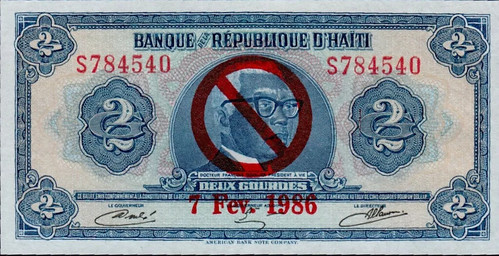
I don't believe we've discussed this overstamp before. February 7, 1986 was the day Haiti's President Jean-Claude “Baby Doc” Duvalier left the country following protests over his family's 28-year rule.
I haven't found anything about this overstamp on the Newman Numismatic Portal or on the web. Can anyone help? Thanks. -Editor
For more information, see:
Anti-Duvalier protest movement
(https://en.wikipedia.org/wiki/Anti-Duvalier_protest_movement)
Haitians overthrow regime, 1984-1986
(https://nvdatabase.swarthmore.edu/content/haitians-overthrow-regime-1984-1986)
DUVALIER FLEES HAITI TO END FAMILY'S 28 YEARS IN POWER: GENERAL LEADS NEW REGIME; 20 REPORTED DEAD
(https://www.nytimes.com/1986/02/08/world/duvalier-flees-haiti-end-family-s-28-years-power-general-leads-new-regime-20.html)
Video: Pre-Decimal British coinage
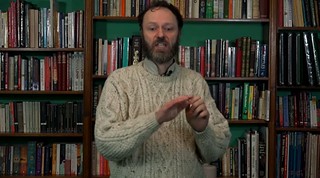 Chip Howell writes:
Chip Howell writes:
"I follow this guy on YouTube for his historical videos. He does a pretty good survey of what the British used pre-decimal--runs about an hour."
Nicely done. He has many followers. Check out the comments:
"I feel I'm sitting in a university lecture, except that it's interesting."
"Half way through a great stand up comedy routine before I realized that I was learning something. Damn it! In a time of so much stupidity i just got smarter."
"Neil Stevenson's "Baroque Cycle" is a huge historical fiction trilogy which goes in depth into Newton and his time with the Mint."
-Editor
To read the earlier E-Sylum article, see:
Pounds, shillings, and pence: a history of English coinage
(https://www.youtube.com/watch?v=R2paSGQRwvo)
Banjo Paterson's 120 Year Old War Chocolate
Gerry Tebben writes:
"You can't go wrong when you mix money and chocolate. This BBC report on the recent discovery of Banjo Paterson's 120 year old war chocolate is a delight. Paterson's the guy on the Australian $10 bill and the author of Waltzing Matilda."
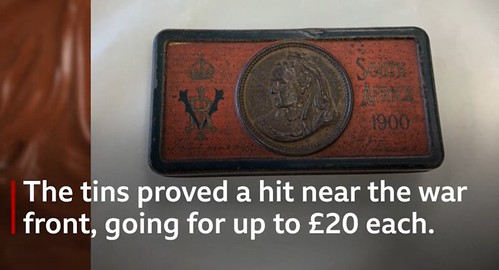
When the National Library of Australia recently acquired famous poet Banjo Paterson's personal belongings, the last thing they expected to find was chocolate.
With links to Queen Victoria, the discovery from 1900 is "one of the best preserved chocolates of this age anywhere", a historian tells the BBC.
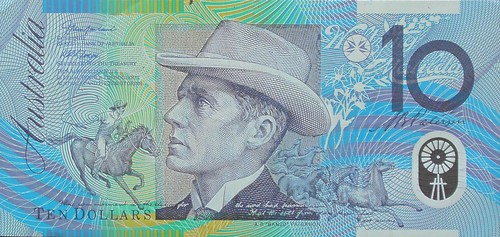
The ten dollar polymer banknote from Australia with the portrait of A.B. Banjo Paterson.
Since the COVID lockdowns I've been consuming more alcohol and candy at home. But it's all good for you, right? Who am I to question the scientists hired by the red wine and chocolate industries? -Editor
Gerry adds:
"Funny thing about the virus. We stopped eating out in March. With just home-cooked meals, no real dieting, I’m down 30 pounds and my blood pressure has dropped to normal levels. We hope to get the vaccine in January and are already putting together a list of restaurants we want to go back to. It’s going to be a battle."
I had begun dieting last fall and had already lost over twenty pounds before the lockdown hit, and continued losing 'til I was down 27 pounds. But restaurant take-out and holiday foods have taken their toll and I've regained 10. Circle of life in the restaurant-industrial complex. -Editor
To read the article (and see the video), see:
Banjo Paterson: 120-year-old chocolate found in Australian poet's belongings
(https://www.bbc.com/news/av/world-australia-55421008)
More Movies With Banknote Themes
Phil Iversen writes:
"Regarding your article on Movies With Banknote Themes, the first one brought to mind is A Fistful of Dollars starring Clint Eastwood. A good source for more is the great book "Show Me The Money" written by Fred Reed. Among the many movies listed include The Banknote, The Adventures of a Ten Mark Note, How They Make Dollar Bills and many more with numismatic related subjects."
I wouldn't call A Fistful of Dollars numismatic, but the others may have a connection other than a word in the title. I was unable to find more information about these online. I do have a copy of Fred's book and recommend it to anyone with an interest in stage money / prop notes. -Editor
To read the earlier E-Sylum article, see:
Movies with a Banknote Theme
(https://www.coinbooks.org/v23/esylum_v23n51a13.html)
Congress: No Dollar Bill Redesign
Kellen Hoard writes:
"In the new funding bill Congress just passed, it was specifically dictated that there be no redesign of the $1 bill. Pretty interesting!"

I have heard of this before - It's a standard provision in recent budgets. The text as shown is "None of the funds appropriated in this Act or otherwise available to the Department of the Treasury or the Bureau of Engraving and Printing may be used to redesign the $1 Federal Reserve note."
Here's a short note from the BEP website about the provision. It was introduced by Florida Representative Ander Crenshaw in 2014. Does anyone have more information on the backstory? Thanks. -Editor
"Because the $1 note is infrequently counterfeited, the government has no plans to redesign this note. In addition, there is a recurring provision in Section 116 of the annual Financial Services and General Government Appropriations Act that prohibits the redesign of the $1 note."
For more information, see:
U.S. Currency $1 Note Issued 1963 - Present
(https://www.moneyfactory.gov/uscurrency/1note.html)
H.R.5016 - Financial Services and General Government Appropriations Act, 2015
(https://www.congress.gov/bill/113th-congress/house-bill/5016/text)
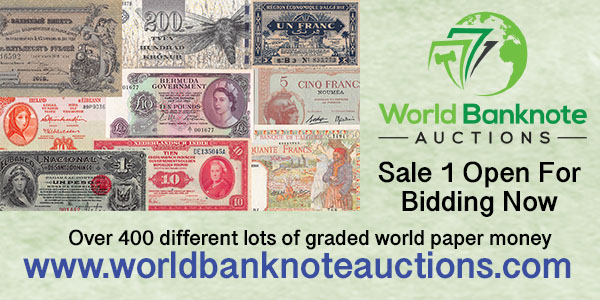
VOCABULARY TERM: COIN COUNTER
Dick Johnson submitted this entry from his Encyclopedia of Coin and Medal Terminology. Thanks. I added an image from a 2015 Stephen Album Rare Coins auction of a rare two-side coin board - one side holds 100 coins, the other 200. -Editor
Coin Counter. A device or machine to determine the precise number of coins. Once the production of coins increased to large numbers in mints after the industrial revolution, manual counting of coins could not keep up with the capacity of the coining presses.
Counting board. The first device used, both in England, America and elsewhere, was the counting board. Devised in the early 19th century it was used into the 20th century. The first models had the required number of circular depressions in a flat board – slightly larger than the diameter of the coins being counted – but of equal depth as the coin was thick. The coins would easily fall into these openings, but a second one would not. The mint required a different board for each denomination. Coins were dumped on these and spread around by hand until they filled every depression. Excess coins were returned to the hopper from which they came.
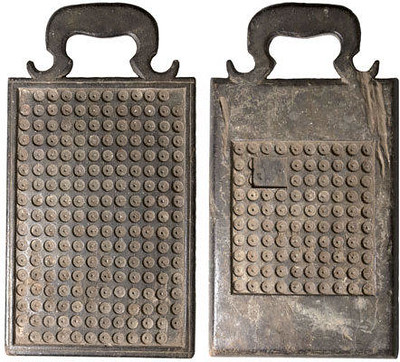
wooden chuckram counting board, 19th century
Later models had channels built into the board the width of the coin. Even later ones had brass rails the thickness of the coin to create these channels. The board was supported on the underside in the center by a horizontal axle, much like a teeter totter. Coins would be spread over the channels on the top side, then tilted toward one worker to allow excess coins to fall back into the hopper. After visual inspection that all channels were full they would tip the board in the opposite direction for the coins to fall out of the channels.
The coins would then be funneled into cloth bags. Amazingly, one report states 400 coins could be counted in 12 seconds with two men, one dumping and spreading the coins, one pouring counted coins into a bag and tying it off.
Counting machines. When even this proved inadequate to keep with the outpouring from the presses, the manufacturers of rolling mills turned also to creating machines for counting coins. The first coin counter – the British called them automatic telling machines – were developed by Maudslay, Sons, and Field, and installed in 1891 at the British Royal Mint.
Technology further increased the usefulness of these machines, which could be used with wrapper rolling mechanisms to automatically count and roll coins to a prescribed number. This was ideal for use in bank's counting rooms, more so than in mints, which preferred to continue bagging coins in cloth sacks in large quantities.
References:
CH12 {1885} Evans, p 40.
C82 {1988} Cooper (counting board) p 208.
CH76 {1992} Challis, p 538.
Looking for the meaning of a numismatic word, or the description of a term? Try the Newman Numismatic Portal's Numismatic Dictionary at: https://nnp.wustl.edu/library/dictionary
Or if you would like a printed copy of the complete Encyclopedia, it is available. There are 1,854 terms, on 678 pages, in The Encyclopedia of Coin and Medal Technology. Even running two a week would require more than 19 years to publish them all. If you would like an advance draft of this vital reference work it may be obtained from the author for your check of $50 sent postpaid. Dick Johnson, 139 Thompson Drive, Torrington, CT 06790.
WILLIAM PRESTON BEAVER (1865-1927)
John Lupia submitted the following information from the online draft of his book of numismatic biographies for this week's installment of his series. Thanks! As always, this is an excerpt with the full article and bibliography available online. This week's subject is William Preston Beaver of New Kensington, Pennsylvania (later New Jersey and New York). -Editor
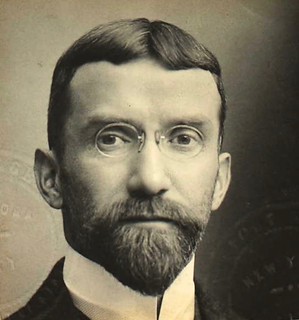 William Preston Beaver (1865-1927), was born on September 5, 1865 at Lewisburg, Pennsylvania, the son of Peter Beaver (1816-1890) and Mary Ann Armstrong (1823-1912). He is the great-grandson of Thomas Preston. He worked as a clerk for the Pennsylvania Railroad in 1885, working in Philadelphia, Pennsylvania. He was a member Sigma Chi fraternity. He graduated with a B.A. Capitalist. He was listed as living at 82 Park Street, Montclair, New Jersey at that time. He graduated Bucknell University, Pennsylvania, with an M.A. in 1885. He was listed as living at Bloomfield, New Jersey at the time. He worked as the Secretary of the Pittsburgh Tin Plate Works, New Kensington, Pennsylvania. Later on as auditor. On January 8, 1895, he married Ellen Brooks (1871-), daughter of Charles Preston and Mary Hurley Brooks of East Orange, New Jersey. She was a graduate of Wellesley College. Late fall in 1895 they had a daughter Miriam.
William Preston Beaver (1865-1927), was born on September 5, 1865 at Lewisburg, Pennsylvania, the son of Peter Beaver (1816-1890) and Mary Ann Armstrong (1823-1912). He is the great-grandson of Thomas Preston. He worked as a clerk for the Pennsylvania Railroad in 1885, working in Philadelphia, Pennsylvania. He was a member Sigma Chi fraternity. He graduated with a B.A. Capitalist. He was listed as living at 82 Park Street, Montclair, New Jersey at that time. He graduated Bucknell University, Pennsylvania, with an M.A. in 1885. He was listed as living at Bloomfield, New Jersey at the time. He worked as the Secretary of the Pittsburgh Tin Plate Works, New Kensington, Pennsylvania. Later on as auditor. On January 8, 1895, he married Ellen Brooks (1871-), daughter of Charles Preston and Mary Hurley Brooks of East Orange, New Jersey. She was a graduate of Wellesley College. Late fall in 1895 they had a daughter Miriam.
He was collecting U. S. Colonials and tokens and medals since at least 1889 until at least March 1896 from the Chapman Brothers. According to the 1900 U.S. Census he and his wife were living at her parents' home in East Orange, New Jersey. According to his passport in November 1904 he lived in Glen Ridge, New Jersey. While at Glen Ridge, they had two sons William Preston Beaver, Jr (1901-1904) and Gilbert Beaver (1903-1904) who both died in their infancy in 1904.
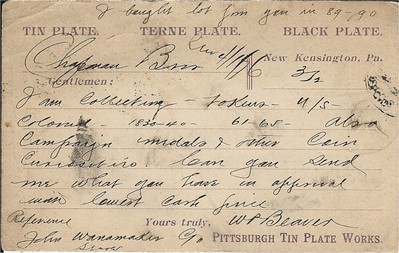
Company Postal Card from William Preston Beaver to the Chapman Brothers postmarked March 2, 1896 from New Kensington, Pennsylvania.
"I bought lot from you in 89-90. I am collecting - tokens - U/S - Colonial- 1830-40 - 61-65 - also Campaign medals & other coin Curiosities. Can you send me what you have on approval with lowest cash price. W.P. Beaver. Reference John Wanamaker C/o Store."
In March 1908 he traveled to Athens, Greece. According to his 1916 passport he lived in Montclair, New Jersey, when he took a cruise that October from the port of Seattle, Washington to Japan, Siam, Java, Hong Kong, Singapore, Burma, and India aboard the Express of Russia sailing out of Vancouver. In 1920 he travelled to Havana, Cuba. According to the 1921 SS Nieuw Amsterdam passenger list sailing from Plymouth, England to NYC he lived at 104 East 40th Street, New York City, New York. In 1924 he traveled to Genoa, Italy aboard the Conte Verde.
He died on February 25, 1927 at Manhattan, New York.
To read the complete article, see:
BEAVER, WILLIAM PRESTON
(http://www.numismaticmall.com/numismaticmall-com/beaver-william-preston)

JULIUS DREIFUS AND THE 1804 DOLLAR
Pete Smith submitted this article on the background of the Dreifus-Rosenthal specimen of the 1804 dollar, now residing in the collection of the ANS. Thanks! -Editor
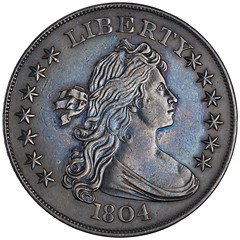
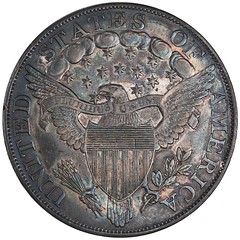
Julius Driefus and the 1804 Dollar
Superintendent of the Philadelphia Mint, Oliver Bosbyshell, wrote a letter to James W. Ellsworth on February 15, 1894, authenticating an 1804 dollar in his possession. The Bosbyshell letter stated:
“The 1804 Silver Dollar purchased by me, for you today, from Mr. Isaac Rosenthal of 190 Berks Street, this city, came into his possession in the following manner: A Mr. Julius Driefus, Nos. 3 & 4 South Wharves, Alexandria, Va. does business for Mr. Rosenthal, and borrowed money from him. Mr. Driefus met with a colored man who had this dollar for forty years, that he received it from his father, who was a freedman -the father kept the dollar because it either was the date of his birth, or the date he became a freedman...”
Also attesting that this was a genuine dollar struck in 1804 were curator Robert A. McClure, engraver Charles E. Barber, assayer Jacob B. Eckfeldt, and A. Louden Snowden. With this testimonial of authenticity, Ellsworth bought the dollar, now known as the Driefus-Rosenthal Specimen. This was later acquired by Farran Zerbe, exhibited with the Chase National Bank Collection and acquired by the American Numismatic Society in 1978.
The Bosbyshell letter refers to Julius Driefus, but the Newman – Bressett book on The Fantastic 1804 Dollar refers to him as W. Julius Driefus. That added initial letter adds to the confusion. In his book, The Rare Silver Dollars Dated 1804, Q. David Bowers expressed some skepticism about the pedigree since the coin, a class III 1804 dollar, had been produced less than 40 years earlier.
Earlier this month (December 2020) I attempted to find more biographical information about W. Julius Driefus. Every mention led back to the Bosbyshell letter but there was no independent confirmation that such a man lived in Alexandria at that time. I began to believe that the Bosbyshell pedigree was a fabrication to add support for the fabricated dollars of 1804.
Then I made a discovery and more facts fell into place. The Findagrave site lists Julius Dreifus, born on August 27, 1841, and died on September 6, 1910. The site lists his parents, siblings, spouses and children.
The difference in spelling, from Driefus to Dreifus may be understood as coming from transmission of information by word-of-mouth, rather than a written record. With this corrected spelling, I found a photo of his building and copies of business ads.
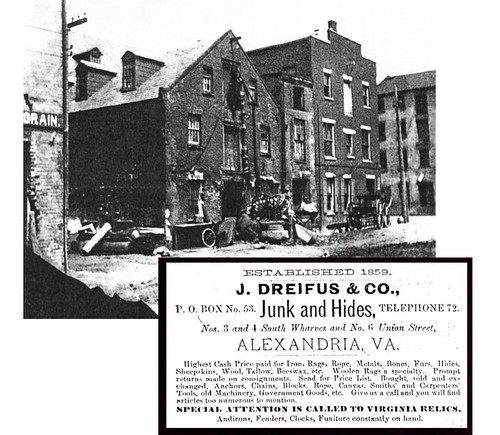
I had trouble locating Nos. 3 and 4 South Wharves and asked for help. Wayne Homren referred me to Joe Esposito. He reported that the location was at South Union and King Streets and now had a Starbucks. This would represent a gentrification over the junk shop that was there about 1893.
These discoveries do not prove that Dreifus owned an 1804 dollar, but they do prove there was a man and location that match the Bosbyshell story.
Thanks. This is the second time in as many weeks that the Findagrave site has assisted an E-Sylum numismatic researcher in locating information. Remember that the next time you're looking for a person - nearly everyone who's lived in recent centuries ends up in a cemetary or mausoleum. -Editor
To read the ANS museum catalog entry, see:
Silver dollar of the United States, Philadelphia (Pa.), 1804. 1980.66.1
(http://numismatics.org/collection/1980.66.1)
To read the earlier E-Sylum article, see:
ROBERT J. DODGE (1825-1892)
(https://www.coinbooks.org/v23/esylum_v23n51a20.html)
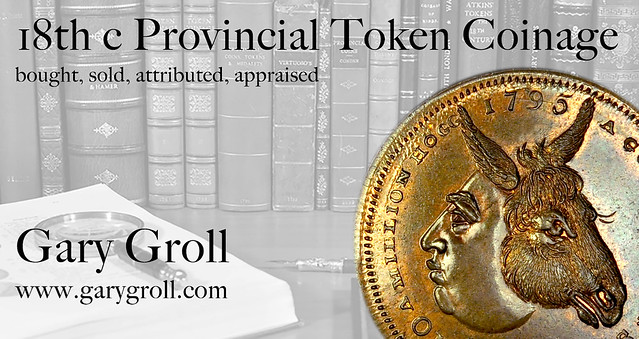
THE 2021 ANS GALA
The global pandemic won't halt the 2021 ANS Gala. The major annual event is going online. Here's the press release. -Editor
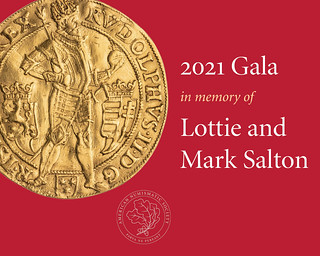 The American Numismatic Society (ANS) is pleased to announce that on Thursday, January 14, 2021, it will hold its annual Gala celebration, virtually, in memory of benefactors Mark and Lottie Salton. The Gala will be open, via Zoom, to members of the Society and their guests.
The American Numismatic Society (ANS) is pleased to announce that on Thursday, January 14, 2021, it will hold its annual Gala celebration, virtually, in memory of benefactors Mark and Lottie Salton. The Gala will be open, via Zoom, to members of the Society and their guests.
The event will feature keynote speaker Jacob Goldstein—NPR correspondent, co-host of the Planet Money podcast, and author of the new book MONEY: The True Story of a Made-Up Thing. The program will also feature a new video about the ANS and a presentation on the honorees by Dr. Ira Rezak and Dr. Alan Stahl. The event will close with a special raffle consisting of approximately 20 items, including Greco-Roman coins, medals from the Medallic Art Company (MACO) and other modern-period objects, cut sapphires, signed books and much more.
Honorees Mark and Lottie Salton, both born in Germany, were forced by the Nazis to flee their homeland. Each managed to reach the United States in the 1940s, where they met and later married in 1948. They enjoyed an extraordinarily close partnership until Mark’s death 57 years later. Though he came from a family of bankers and numismatists, Mark had to start from scratch in America, eventually receiving a graduate degree in International Banking. Lottie, who had been only 14 years old when she escaped Germany, did not share his scholarly background. Once married, she not only enthusiastically adopted Mark’s numismatic fascination but also acquired extensive expertise of her own. Together, they pursued a wide range of interests including a special pleasure in medallic art of the Renaissance and early Baroque.
At the ANS, Mark Salton was a Life Fellow, Chairman of the Huntington Award Committee, and a member of the J. Sanford Saltus Medal Committee. Lottie and Mark were also magnanimous donors, giving to the ANS many gifts of coins and medals as well as contributions to its appeals. Very soon after Mark’s death in 2005, Lottie became an ANS Honorary Life Fellow and established the Mark M. Salton memorial lecture series at the ANS. Before she died at age 96 in the spring of 2020, in one final extraordinary gesture of largesse, Lottie Salton named the ANS in her will, leaving the Society a bequest of $500,000 to help sustain a chair for Medieval and Renaissance numismatics. Her bequest is a remarkable legacy from a remarkable couple, who will always be remembered very fondly by those who were privileged to know them.
Past recipients of the Trustees’ Award include such notable numismatists and donors as Ms. Shelby White and Mr. Leon Levy, Mr. Jamie Stewart, Mr. Kenneth L. Edlow, Mr. George Kolbe, Mr. Q. David Bowers, Mr. Chester L. Krause, Mr. Donald G. Partrick, Mr. Harvey Stack, Mr. Victor England, Jr., Mr. Ira Goldberg, Mr. Larry Goldberg, Mr. Harlan J. Berk, Mr. Roger S. Siboni, Mrs. Marian Scheuer Sofaer and the Honorable Abraham D. Sofaer, Mrs. Elizabeth Forbes Hazard Scott and Mr. Stanley DeForest Scott, and Mr. and Mrs. John W. Adams, Anthony J. Terranova, the Eric P. Newman Numismatic Education Society and the Newman Numismatic Portal, the Rosen Family, Mike Gasvoda, and Richard M. Beleson.
Every year the American Numismatic Society raises critical revenue through the Gala. These funds are used to further the Society’s mission of supporting research and education in numismatics.
For information on the program, bios, raffle items and supporting the virtual event, please contact Austin Andrews at 212-571-4470, ext. 117; membership@numismatics.org; or visit the ANS website: numismatics.org/2021-ans-gala.
To read the complete press release, see:
Press Release: The American Numismatic Society Announces 2021 Gala
(http://numismatics.org/press-release-ans-2021-gala/)
For more information, see:
ANS Gala 2021
(http://numismatics.org/2021-ans-gala/)

TREASURY CHOOSES NEW QUARTER REVERSE DESIGN
On Christmas Day the U.S. Treasury announced its choice for the new design of the reverse of the Washington quarter. First, some background from Coin Update published December 21, 2020. See the complete article online for all the candidate designs. -Editor
December 25, 2020, will bring an extra holiday gift to the coin-collecting community. On Christmas Day, the United States Mint will announce the design of the new “Washington Crossing the Delaware” quarter dollar.
Since 2010 the Mint has produced circulating commemorative quarters honoring national parks, forests, and other sites of natural and historical significance, in the “America the Beautiful” coin program. Public Law 110-456 authorized a change to the reverse of the quarter dollar after this series concludes in 2021. The program’s 56th and final quarter (which honors the Tuskegee Airmen National Historic Site) will be released next year. After that, the law states, the reverse of the quarter dollar “Shall contain an image of General Washington crossing the Delaware River prior to the Battle of Trenton.”
The Citizens Coinage Advisory Committee reviewed potential designs more than a year ago, in October 2019. Each of the candidates depicted General George Washington leading his troops across the ice-choked Delaware River during a Nor’easter, the evening of December 25/26, 1776. Their movement was part of Washington’s plan to surprise the British in New Jersey. The ensuing Battle of Trenton and later Battle of Princeton became turning points in the Revolutionary War. Washington gave hope to many patriots that the Continental Army could win American independence.
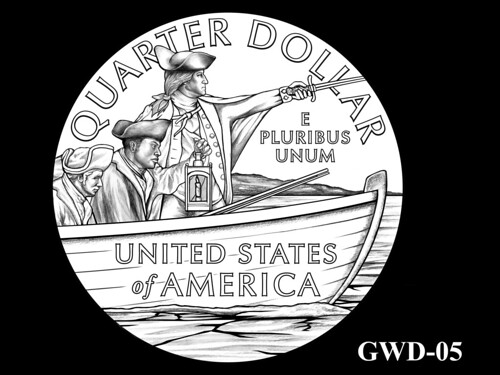
In the CCAC’s October 15, 2019, meeting, the Mint noted that “Artists were charged with finding a fresh perspective to depict the theme and encouraged not to recreate the 1999 New Jersey quarter which evokes the famous painting by Emanuel Leutze. The racial diversity present in Washington’s troops is represented, as is the Grand Union Flag which was the flag in use at the time of the crossing.” The Mint worked with curators at Mount Vernon to ensure historical and technical accuracy in the designs.
The design recommended by the CCAC was #12, with General Washington in the foreground, holding a telescope and gesturing forward with his sword. In the background is a boat full of Continental Army troops negotiating the icy waters.
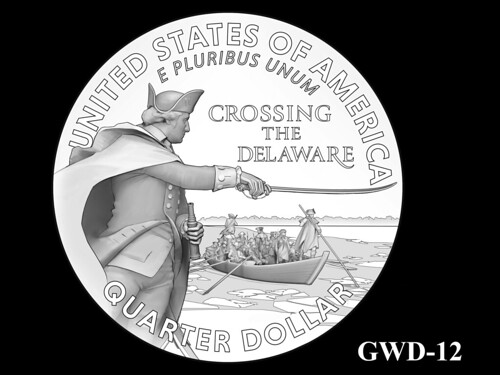
So what design was chosen? Here's the Mint Press Release (Colonial-era drumroll, please....) -Editor
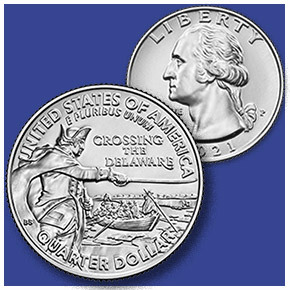 On this night in 1776, General George Washington, along with 2,400 troops and artillery, began his historic crossing of the Delaware River in preparation for a surprise attack on British and Hessian soldiers during the American Revolutionary War. Today, the United States Mint (Mint) is unveiling a new design depicting this pivotal moment in history which will be displayed on the reverse (tails) of the quarter-dollar coin beginning in 2021. The design will begin circulating following the issuance of the final coin in the America the Beautiful Quarters® Program.
On this night in 1776, General George Washington, along with 2,400 troops and artillery, began his historic crossing of the Delaware River in preparation for a surprise attack on British and Hessian soldiers during the American Revolutionary War. Today, the United States Mint (Mint) is unveiling a new design depicting this pivotal moment in history which will be displayed on the reverse (tails) of the quarter-dollar coin beginning in 2021. The design will begin circulating following the issuance of the final coin in the America the Beautiful Quarters® Program.
The new design depicts General Washington commanding his troops through the overnight crossing of the ice-choked Delaware River prior to the Battle of Trenton during the American Revolutionary War. Inscriptions are “UNITED STATES OF AMERICA,” “E PLURIBUS UNUM,” “CROSSING THE DELAWARE,” and “QUARTER DOLLAR.” Artistic Infusion Program Designer Benjamin Sowards created the design which was sculpted by Medallic Artist Michael Gaudioso.
In accordance with the authorizing legislation, the obverse (heads) of the quarter dollar will revert to renowned designer John Flanagan’s design featuring President Washington that appeared on the coin before the 50 State Quarters Program.
Washington Crossing the Delaware quarters will be released into circulation by the Federal Reserve Banks on April 5, 2021.
To read the complete article, see:
United States Mint Announces New Quarter Dollar Reverse Design
(https://www.usmint.gov/news/press-releases/mint-announces-new-quarter-dollar-reverse-design)
A good choice, I think. I'll be curious to see the actual coins in hand. Thanks to Pabitra Saha, Ultra modern Numismatist for passing along the earlier Coin Update and CoinNews articles.
Pabitra asked a great question - "What is reversion of obverse?" Over the years mint personnel gradually reworked the original obverse design until it diverged significantly from the original design of 1932. The obverse will return to that original design. I remember glancing at a quarter one day aghast at what had happened. "Sweet Jesus! WHAT have they DONE????!!!" Old George had developed spaghetti hair. It will be great to return to the artist's original vision. -Editor
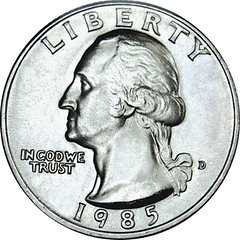
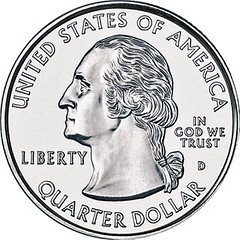
To read the complete articles, see:
George Washington’s newest coin will be announced Christmas Day
(http://news.coinupdate.com/george-washingtons-newest-coin-will-be-announced-christmas-day/)
George Washington Crossing the Delaware River Quarter Designs Recommended
(https://www.coinnews.net/2019/11/01/george-washington-crossing-the-delaware-river-quarter-design/)
To read the earlier E-Sylum article, see:
THE 2017-P MINTMARKED CENT
(https://www.coinbooks.org/v20/esylum_v20n04a18.html)
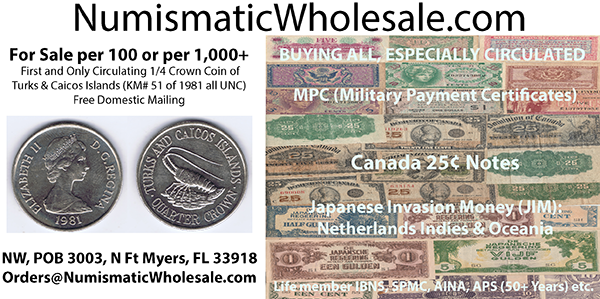
SENATE BILL WOULD RESTRICT TRADING OF MEDALS
Frank Draskovic alerted us to a new bill in the U.S. Senate that would further restrict the business of buying and selling military decorations, medals, and related items. -Editor
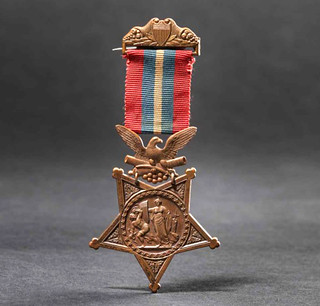 On December 10, 2020, Senator Ted Cruz (R-Texas) introduced he Limiting and Enabling Gathering Awards Commemorating Yesteryear (LEGACY) Act, legislation to facilitate the repatriation of medals, including the Congressional Medal of Honor (MoH), into the United States for display in museums and for educational purposes.
On December 10, 2020, Senator Ted Cruz (R-Texas) introduced he Limiting and Enabling Gathering Awards Commemorating Yesteryear (LEGACY) Act, legislation to facilitate the repatriation of medals, including the Congressional Medal of Honor (MoH), into the United States for display in museums and for educational purposes.
The far-reaching bill attempts to make it illegal for non-approved individuals or businesses to buy, possess, sell, or import US military medals from outside of the United States.
According to Cruz's press release, however, he does endorse the yet-to-be-constructed "National Medal of Honor Museum" as an appropriate recipient of any errant medals. And where is this museum to be built? It isn't hard for you to guess — Cruz's home state of Texas.
Cruz's impetus for the bill was the sale of a Medal of Honor through the Munich-based auction company, Herman Historica. While it is illegal in the United States to buy, sell, or even possess a Medal of Honor (that was not awarded to you or a family member), it is perfectly legal for sales to occur off of United States soil. The Medal of Honor Museum Foundation attempted to block the sale, alerting Cruz to their inability to legally purchase the Medal.
So now, Cruz has authored a bill that, in essence, throws out the baby with the bathwater. If passed, military historians, medal collectors, and dealers will have to get on Cruz's "good list" to be able to own, buy, or sell medals.
A Medal of Honor Museum itself is a fine idea, and would be a great counterpart to museums abroad featuring the Victoria Cross medals. But further restricting the sale of medals is not the way to go about it. The bill would attempt to impose restrictions on foreign sales by placing sanctions against the sellers. It is an attempt to fix a problem that only exists because of earlier equally misguided legislation. -Editor
Frank writes:
"Once again, this dragon rears its ugly head. Start writing letters and emails now. Tell your collector pals. Spread this news on forums you participate in. Get pro-active. Nip it in the bud. It's your hobby!
"Explain to Cruz, and others in Congress who may be sympathetic to this bill, what medal collecting is about, historical aspects, preservation, etc., and why a ban on collecting is a bad idea."
To read the complete article, see:
Senator Cruz launches bill to curtail private ownership of military medals
(https://www.militarytrader.com/militaria-collectibles/bill-curtails-moh)
To read the press release, see:
Sen. Cruz Introduces Legislation to Facilitate the Repatriation of Medals of Honor
(https://www.cruz.senate.gov/?p=press_release&id=5506)
To read the complete bill, see:
https://www.cruz.senate.gov/files/documents/2020.12.11_ARM20F95.pdf

DAVISSON'S E-AUCTION 38 SELECTIONS
Here are some items that caught my eye in the upcoming Davisson's E-Auction 38 closing January 6, 2021. -Editor
Lot 12: Ainos Tetradrachm
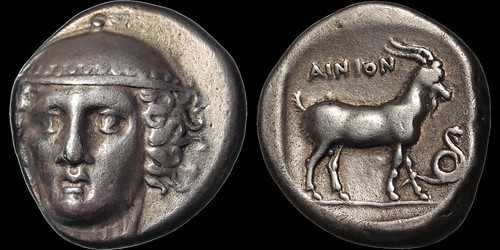
THRACE. Ainos. Circa 412-365 B.C. AR tetradrachm. 15.36 gm. 23 mm. Head of Hermes facing slightly left, wearing petasos / Goat standing right; AINION above, serpent in field to right, all within shallow incuse square. HGC 3.2, 1278. SNG Copenhagen 410. Very Fine; attractive old toning.
Great relief on the head. -Editor
To read the complete lot description, see:
https://davcoin.com/lot/e-auction-38-lot-12
Lot 18: Argos Triobol
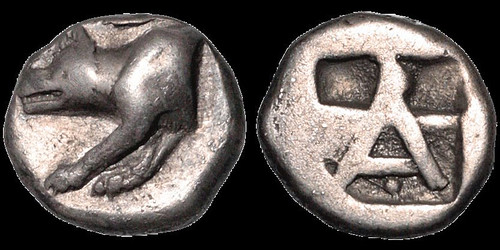
PELOPONNESOS. ARGOLIS. Argos. Circa 480/470-440/430 B.C. AR triobol. 2.97 gm. 13 mm. Forepart of wolf at bay to left, both legs extended forward and head held level / Large A within shallow incuse square; two relatively shallow square incuses in the upper part; pellet below cross bar. HGC 5, 663. Cf. BCD Peloponnesos 1022ff. BMC Peloponessus 136: 9-11. Good Very Fine; high relief wolf; attractive for this issue. Very rare.
Ex BCD with tag.
BCD: "Archaic triobols (such as this one) usually turn up much more worn;...they were part of the staple Peloponnesian currency down to the 2nd century B.C." and hence were well used.
Love the wolf. -Editor
To read the complete lot description, see:
https://davcoin.com/lot/e-auction-38-lot-18
Lot 23: Eukratides I Megas
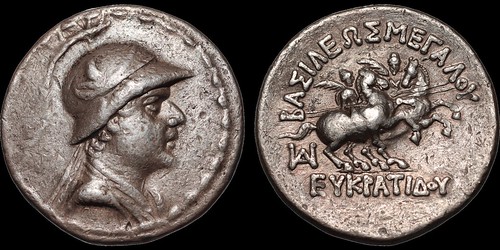
BAKTRIA. Greco-Baktrian Kingdom. Eukratides I Megas. Circa 170-145 B.C. AR tetradrachm. 16.81 gm. 29 mm. His diademed and draped bust right, wearing crested helmet adorned with bull's horn and ear / The Dioskouroi on horses rearing right, holding palms and spears; monogram to left. Bopearachchi 6W. HGC 12, 131. Very Fine; well centered and lighty toned.
Purchased from Jonathan K. Kern (tag).
Eukratides was one of the last but most important Greco-Baktrian kings, responsible for the overthrow of the Euthydemid dynasty and for waging numerous campaigns against the Indo-Greek kings, temporarily holding territory as far east as the Indus. He was murdered on his way home from India, apparently by his son who hated his father so much that he "ran with his chariot over the blood of his father, and ordered the corpse to be left without a sepulture" (Justin XLI, 6). The subsequent civil war between rival members of the dynasty, combined with external pressures from the Indo-Greeks, Sogdians, and Parthians led to the ultimate collapse of the Greco-Baktrian Kingdom a mere fifteen years later, when it was conquered by the Parthians under Mithradates.
I guess it's the helmet that attracted me to this one. -Editor
To read the complete lot description, see:
https://davcoin.com/lot/e-auction-38-lot-23
Lot 46: Elagabalus Denarius
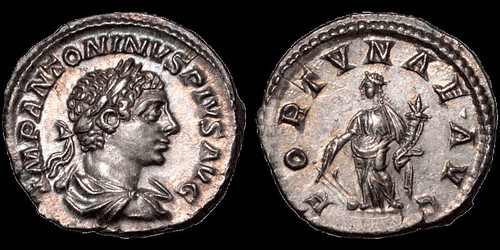
Elagabalus. A.D. 218-222. AR denarius. 2.85 gm. 18 mm. Rome mint. Struck A.D. 219-220. His laureate and draped bust right; IMP ANTONINVS PIVS AVG / Fortuna standing left, holding rudder on globe and cornucopia; FORTVNAE AVG. RIC IV.2 80. RSC 46. Choice Extremely Fine; fresh minty surfaces; lustrous iridescent toning.
From an old European collection.
Great high condition coin. -Editor
To read the complete lot description, see:
https://davcoin.com/lot/e-auction-38-lot-46
Lot 76: James I Shilling
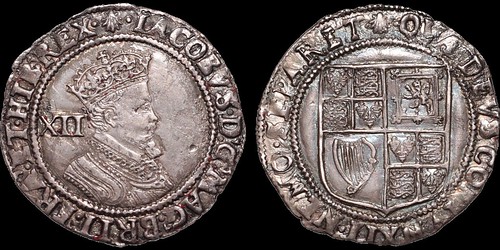
James I. 1603-1625. AR shilling. 5.82 gm. 29 mm. Second coinage, 1604-1619. Fourth bust. Escallop i.m. His bearded fourth bust right, XII behind; IACOBVS D G MAG BRIT FRA ET HIB REX / Square-topped shield; QVÆ DEVS CONIVNXIT NEMO SEPARET around. S. 2655. N. 2100. Near Extremely Fine; well struck on a full round flan; multihued old toning over iridescent surfaces; choice; a scarcer portrait variety.
To read the complete lot description, see:
https://davcoin.com/lot/e-auction-38-lot-76
Lot 77: Charles I Bristol Halfcrown
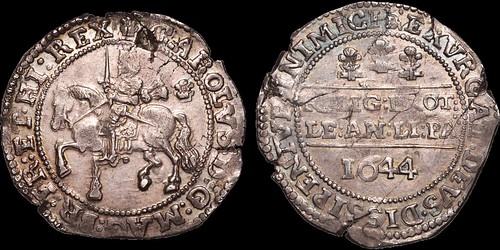
Charles I. 1625-1649. AR halfcrown. 14.28 gm. 38 mm. Plume mm obv, BR (elided) rev. Bristol. 1644. King on horseback left, sash flying out behind; Shrewsbury plume in field / Declaration. S. 3007. N. 2489. Morrieson B-1. As Brooker 980 dies. As minted; fresh, lustrous surfaces; minor flan irregularity. Fascinated by the quality of the strike and the irregularity of the flan I paid a premium for this in 2010. It reflects the turmoil at Bristol during the English Civil War. We offered it unsuccessfully in Auction 36 (2017). The current (reduced) estimate puts it below the price I paid in 2010.
Ex Alan Morris.
Ex Baldwins (bought 11/05 £900; tag "£950").
Includes early tag with the cost 1.7.6. (£1, 7/, 6d).
Fascinating piece. Perfection is overrated - the irregular flan makes it interesting. -Editor
To read the complete lot description, see:
https://davcoin.com/lot/e-auction-38-lot-77
Lot 89: George III Halfpenny Pattern
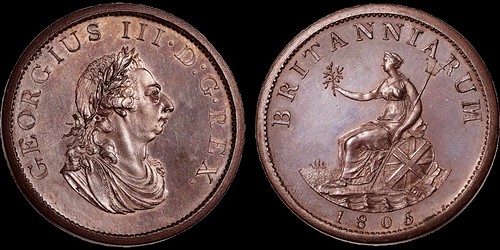
George III. 1760-1820. Bronzed proof halfpenny pattern. 12.86 gm. 30 mm. Restrike by Taylor. 1805 (no currency issues for 1805). His laureate and draped bust right; GEORGIUS III D • G • REX around / Britannia seated left holding olive branch and trident; BRITANNIARUM around, 1805 below. Plain edge. Peck 1246 (S). FDC.
The Frank Robinson Collection.
Beautiful piece. -Editor
To read the complete lot description, see:
https://davcoin.com/lot/e-auction-38-lot-89
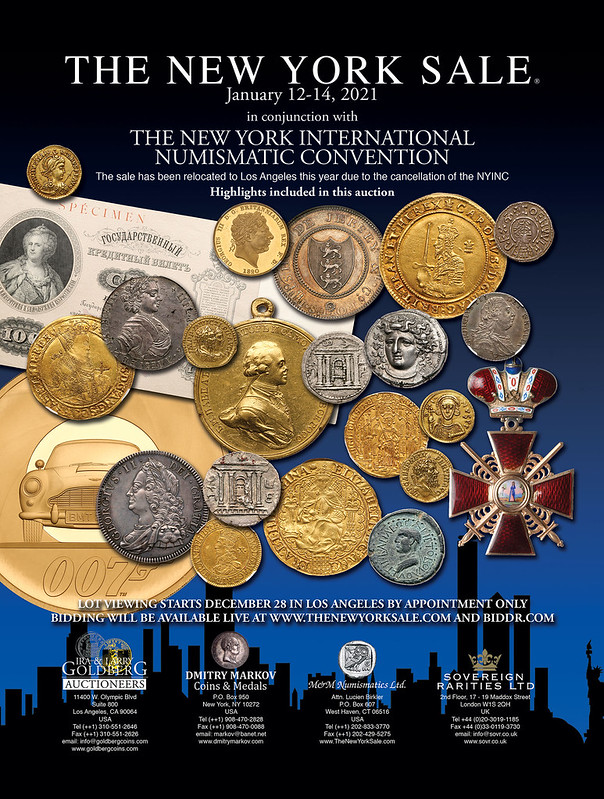
WORLD BANKNOTE AUCTIONS SALE 1 HIGHLIGHTS
Here are some highlights from the upcoming World Banknote Auctions sale. -Editor
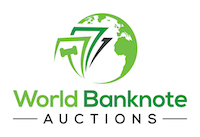 World Banknote Auctions has launched a new website at
www.worldbanknoteauctions.com and we have posted the first auction on the updated platform. Sale 1 is open now and closes on January 7th, 2021, with live bidding that day at 1 PM Eastern / 10 AM Pacific.
World Banknote Auctions has launched a new website at
www.worldbanknoteauctions.com and we have posted the first auction on the updated platform. Sale 1 is open now and closes on January 7th, 2021, with live bidding that day at 1 PM Eastern / 10 AM Pacific.
Offering over 400 lots of graded world paper money, the first sale offers a wide variety of items from all over the world in price ranges for both beginning and advanced collectors. All lots are open for viewing, watching and bidding, and registration with the website is a quick and simple process.
World Banknote Auctions will host sales with live internet bidding every 2 weeks. Bidding for all items starts at just $10 and there is a buyer’s premium of just 15% (with a minimum of $5 per lot), 25% less than the industry average. Shipping rates are flat for most items, with shipping within the United States for just $10 and overseas shipping at $25.
Please check out some of our highlights in Sale 1 below. These and all other lots can be viewed at www.worldbanknoteauctions.com.
Lot 1006: Algeria 1944 50 Francs
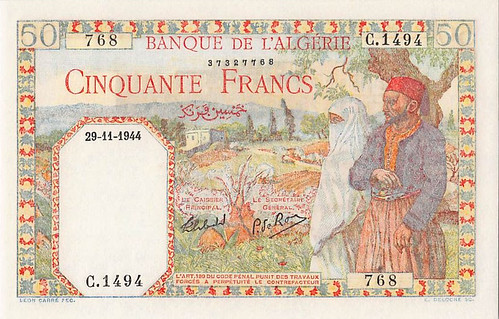
Algeria 29.11.1944 P-87 PMG Gem UNC 66 EPQ 50 Francs
Scarce French-printed type note from Algeria. A small group recently appeared on the market but most have been dispersed already, making now a great time to acquire this well designed type.
Wow - a big, beautiful impressionistic design. -Editor
To read the complete lot description, see:
Algeria 29.11.1944 P-87 PMG Gem UNC 66 EPQ 50 Francs
(https://www.worldbanknoteauctions.com/lots/view/4-1ILIUK/algeria-29111944-p-87-pmg-gem-unc-66-epq-50-francs)
Lot 1034: Belize 1987 20 Dollars
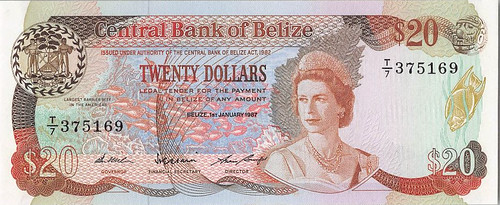
Belize 1.1.1987 P-49b PMG Gem UNC 66 EPQ 20 Dollars
Scarcer denomination from Belize, this one dated 1987 and seen in Gem Uncirculated condition. Perfect for a type collection as this is the most available variety of this date.
A nicely balanced and colorful design. -Editor
To read the complete lot description, see:
Belize 1.1.1987 P-49b PMG Gem UNC 66 EPQ 20 Dollars
(https://www.worldbanknoteauctions.com/lots/view/4-1ILIW4/belize-111987-p-49b-pmg-gem-unc-66-epq-20-dollars)
Lot 1093: Cayman Islands 2001 10 Dollars
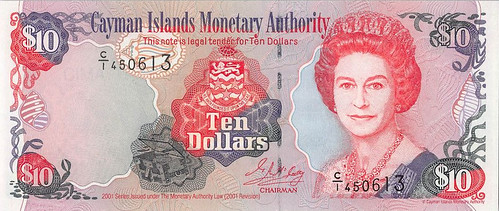
Cayman Islands 2001 P-28a PMG Superb Gem UNC 67 EPQ * 10 Dollars
The finest graded example of this Cayman Islands issue. One other example has been graded 67 EPQ by PMG, but this is the only with star designation, denoting exceptional eye-appeal.
Unusual color combination- I like it. -Editor
To read the complete lot description, see:
Cayman Islands 2001 P-28a PMG Superb Gem UNC 67 EPQ * 10 Dollars
(https://www.worldbanknoteauctions.com/lots/view/4-1ILIZE/cayman-islands-2001-p-28a-pmg-superb-gem-unc-67-epq-10-dollars)
Lot 1218: Bank of Ireland 2017 20 Pounds
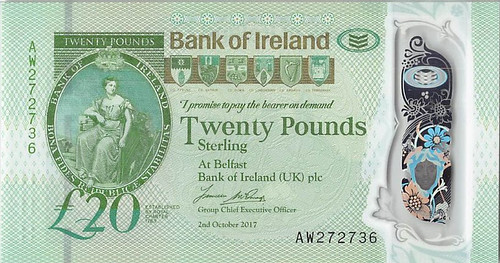
Northern Ireland, Bank of Ireland 2.10.2017 PMG Superb Gem UNC 68 EPQ 20 Pounds
Nice note - a modern one I don't think I'd seen yet. -Editor
To read the complete lot description, see:
Northern Ireland, Bank of Ireland 2.10.2017 PMG Superb Gem UNC 68 EPQ 20 Pounds
(https://www.worldbanknoteauctions.com/lots/view/4-1ILJ6D/northern-ireland-bank-of-ireland-2102017-pmg-superb-gem-unc-68-epq-20-pounds)
Lot 1254: Malaya & British Borneo 1953 10 Dollars
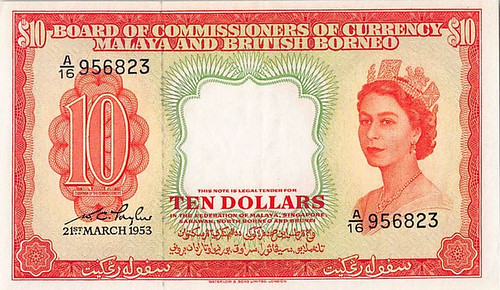
Malaya & British Borneo / British Administration 21.3.1953 P-3a PMG About UNC 50 EPQ 10 Dollars
Lightly circulated example from this popular collecting field. Portrait of Queen Elizabeth II from the early days of her reign on front. Fully original and difficult to find as such.
Another nice note. -Editor
To read the complete lot description, see:
Malaya & British Borneo / British Administration 21.3.1953 P-3a PMG About UNC 50 EPQ 10 Dollars
(https://www.worldbanknoteauctions.com/lots/view/4-1ILJ8D/malaya-british-borneo-british-administration-2131953-p-3a-pmg-about-unc-50-epq-10-dollars)
Lot 1395: Sri Lanka 1979 50 Rupees
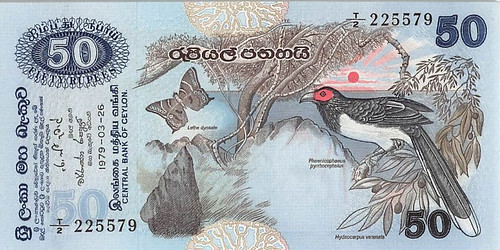
Sri Lanka 26-3-1979 P-87a PMG Superb Gem UNC 67 EPQ 50 Rupees
Second highest denomination from the popular “Flora & Fauna” series from Sri Lanka. Becoming scarce in high grade.
Very colorful! -Editor
To read the complete lot description, see:
Sri Lanka 26-3-1979 P-87a PMG Superb Gem UNC 67 EPQ 50 Rupees
(https://www.worldbanknoteauctions.com/lots/view/4-1ILJG8/sri-lanka-26-3-1979-p-87a-pmg-superb-gem-unc-67-epq-50-rupees)
Lot 1402: Syria 1942 10 Piastres
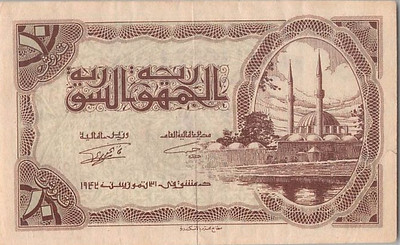
Syria 1942 P-50 PMG About UNC 53 10 Piastres
Lightly circulated example of this scarce World War II issue from Syria. Meant to alleviate a coin shortage caused by the War. Despite its relatively low face value quite difficult to find in problem-free condition.
To read the complete lot description, see:
Syria 1942 P-50 PMG About UNC 53 10 Piastres
(https://www.worldbanknoteauctions.com/lots/view/4-1ILJGM/syria-1942-p-50-pmg-about-unc-53-10-piastres)
To read the earlier E-Sylum article, see:
WORLD BANKNOTE AUCTIONS LAUNCHES NEW WEBSITE
(https://www.coinbooks.org/v23/esylum_v23n51a27.html)
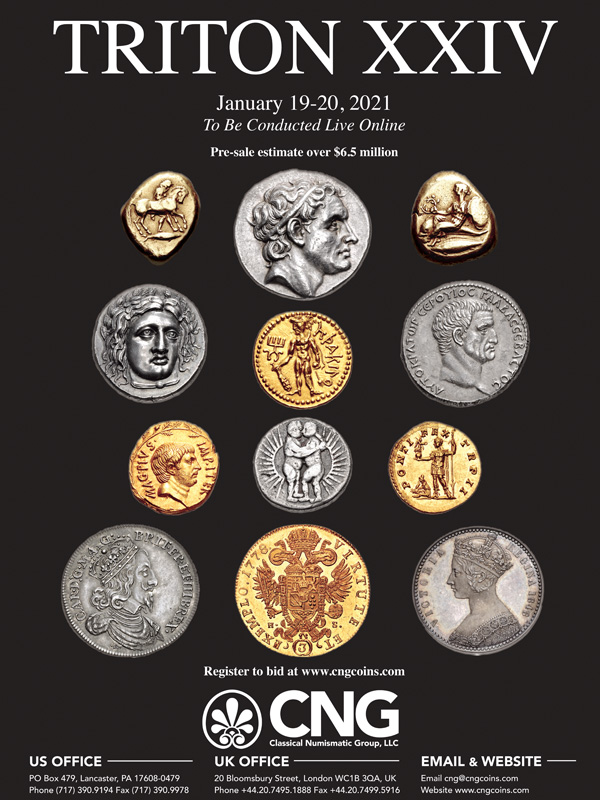
CELTIC GOLD COIN HOARD UNCOVERED
A Celtic gold coin hoard has been uncovered in eastern England. Leon Saryan passed along this Daily Mail article. Thanks, -Editor
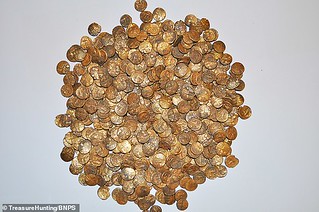 A birdwatcher has stumbled across a hoard of 2,000-year-old Celtic gold coins worth £800,000 that date back to the time Boudicca was at war with the Romans.
A birdwatcher has stumbled across a hoard of 2,000-year-old Celtic gold coins worth £800,000 that date back to the time Boudicca was at war with the Romans.
The keen metal detectorist, who has not been named, spotted a glint of gold while looking at a buzzard in a recently ploughed field in eastern England.
Having rubbed off the mud to reveal a 2,000-year-old gold stater coin, he dashed home to pick up his metal detector and returned to carry on searching.
After digging down around 18ins, he recovered what looked to be a copper bangle, but was in fact the rim of what would have been a jug or urn that housed the coins.
He said: 'Gently lifting it up a cascade of coins fell out, a vision which will remain with me for the rest of my life.
'I had to sit down to get my breath back. I had only come out for a walk and found a Celtic hoard.'
At that moment a friendly dog walker using a public footpath next to the field shouted at to him in jest, 'have you found gold yet?'
The finder said: 'I thought, "if only you knew".
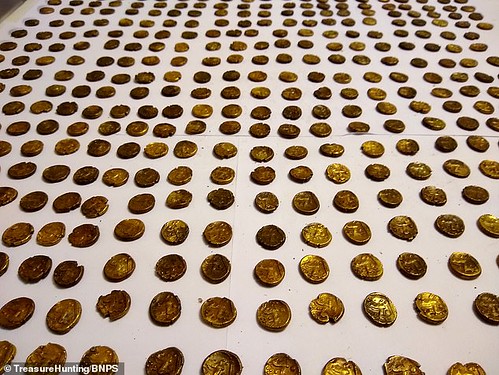
After several hours, and to his utter disbelief, he unearthed about 1,300 coins, all dating to circa 40-50AD.
Experts believe each coin could be worth up to £650, putting the value of the hoard at £845,000.
It comfortably surpasses the previous record Celtic hoard of 850 coins found at Wickham Market, Suffolk, by another detectorist in 2008.
The hoard is currently going through the treasure process in accordance with the Treasure Act 1996.
Birdwatching and metal-detecting are apparently a powerhouse combination of hobbies. Thanks also to Dick Hanscom, Arthur Shippee and others who passed along this story. -Editor
To read the complete article, see:
Birdwatcher stumbles upon £800,000 hoard of 2,000-year-old Celtic gold coins dating from time Boudicca was at war with the Romans
(https://www.dailymail.co.uk/news/article-9084609/Birdwatcher-stumbles-800-000-hoard-2-000-year-old-Celtic-gold-coins.html)
To read additional articles, see:
TREASURE TROVE Britain’s biggest-ever hoard of Celtic gold coins worth £800,000 unearthed by birdwatcher
(https://www.thesun.co.uk/news/13564798/britain-biggest-ever-hoard-celtic-gold-coins/)
Birdwatcher discovers $1M worth of ancient Celtic gold coins
(https://nypost.com/2020/12/24/birdwatcher-discovers-1m-worth-of-ancient-celtic-gold-coins/)
War coin trove linked to ancient rebellion led by Queen Boudicca found in UK
(https://www.jpost.com/archaeology/war-coins-linked-to-ancient-rebellion-led-by-queen-boudicca-found-in-uk-653367)

MEDIEVAL COIN HOARD FOUND IN POLAND
A nice haul of medieval coins was uncovered in Poland. Found via The Explorator newsletter. To subscribe to Explorator, send a blank email message to: explorator+subscribe@groups.io. -Editor
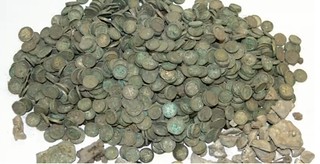 Thousands of 12th century treasures dating back nearly 900 years have been found in a cornfield near Kalisz.
Thousands of 12th century treasures dating back nearly 900 years have been found in a cornfield near Kalisz.
The medieval riches which include coins and jewellery rumoured to have belonged to a Ruthenian princess and sister-in-law of 12-century Polish king Boleslaw the Wrymouth were discovered in the small village of Sluszków.
Inside a pot hidden beneath the earth, archaeologist Dr Adam Kedzierski from the Institute of Archaeology and Ethnology of the Polish Academy of Sciences found 6,500 silver coins arranged in linen pouches, silver ingots, fragments of lead and two gold rings and two wedding bands.
The extraordinary discovery was made after hearing local legends about hidden treasure from the village priest.
Dr Kedzierski said: “According to the official version, the treasure was hidden at the intersection of three plots of land, located in the northern part of the village.
“This news turned out to be false, so this year, attention was focused on the field closer to the road. This place was indicated by Father Stachowiak."
Two days later the archaeologists found the treasure.
He said: “A pot filled to the brim with denarii was found. This is an extremely valuable discovery for archaeologists, historians and museum workers.
“It is one of the most intriguing treasures in Poland. The treasure found in the field in Sluszków near Kalisz comes from the turn of the 11th and 12th century."
To read the complete article, see:
Medieval treasure trove ‘belonging to princess’ found in cornfield following tip off from village priest
(https://www.thefirstnews.com/article/medieval-treasure-trove-belonging-to-princess-found-in-cornfield-following-tip-off-from-village-priest-18571)
THE BOOK BAZARRE
LEXINGTON PIG PENNY ELONGATED CENTS
Shirley Johnson passed along this North Carolina news segment about a man who makes elongated cents promoting the Lexington Barbecue Festival. -Editor
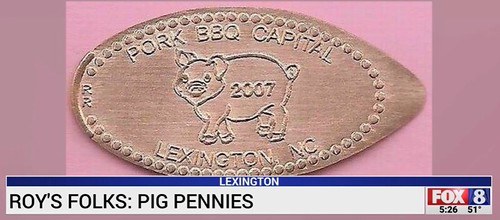
Dwayne Padon transforms ordinary pennies into what he calls Pig Pennies.
“I wanted to just make some souvenirs to promote my hometown,” said Padon, who can trace the practice of creating elongated coins to more than 125 years ago. “1893, the Columbian Exposition – which is now known as the world fair – you’d walk up to a guy, hand him your penny and he would roll it and hand it back to you.”
Padon started making his Pig Pennies back in 2007 to commemorate the Lexington Barbecue Festival.
“First year is still my favorite one, my mom drew it and I said, ‘Just stop, that’s perfect,'” he said.
Every year he comes out with a new design, sometimes multiple designs.
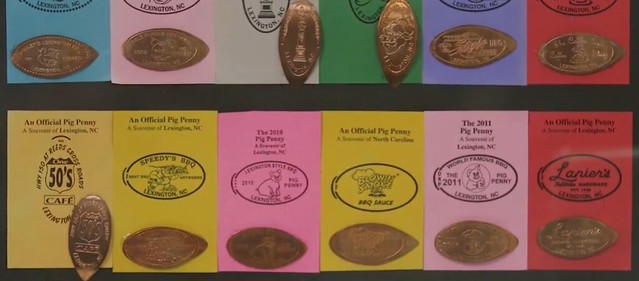
“One year I had seven designs and I said that’s enough,” he said.
Even though the 2020 BBQ festival was canceled because of the pandemic, Padon decided to make one anyway. Just like everything else this year it became a challenge.
“It’s been the most difficult time I’d ever had rolling the coins,” he said. “Usually, I waste two hundred coins getting it set up, this year I’ve wasted about five hundred.”
But finally, 2020 made a lasting impression and maybe it’s fitting as the year winds to a close. We are looking for a little change.
To read the complete article (and watch the video), see:
Lexington man makes ‘Pig Pennies’ to commemorate annual barbecue festival
(https://myfox8.com/roys-folks/lexington-man-makes-pig-pennies-to-commemorate-annual-barbecue-festival/)
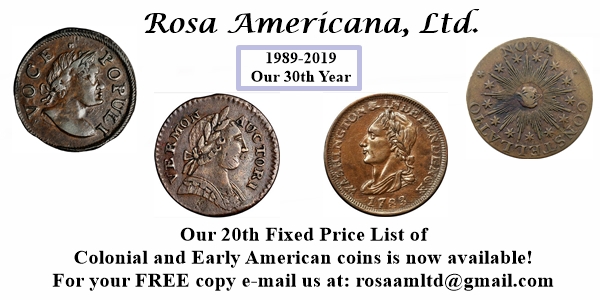
RUSSIAN-AMERICAN WALRUS SKIN NOTE
Heritage is offering a rare Russian-American Company walrus skin note. Here's the press release. -Editor
Rare Paper Money Printed On Walrus Skin Tells the Story of World Trade in the 1800s
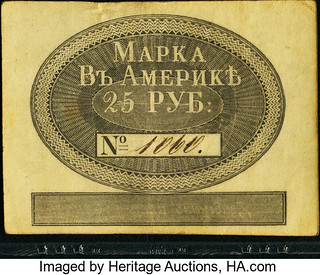
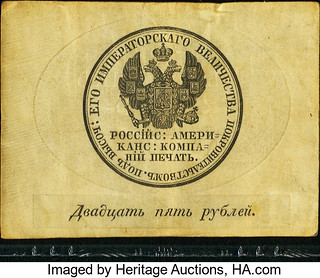
Heritage Auctions will be offering a rare and intriguing piece of paper money in the January FUN Currency Auction #4028: A Russian-American Company 25 Rubles note, graded PMG 55. This note is not dated but was issued in the range of approximately 1816 to 1867.
These notes were printed on walrus skin, making them one of the strangest and most intriguing forms of money to circulate in an American possession: Alaska under Russian influence. Despite previous confusion where some early writers called these seal skin notes, they have since been correctly identified as walrus skin money. These notes were issued by the "Russian American Company," which began in 1781 with a trading company organized by two Russians: Ivan Golikoff and George Shelikoff. They engaged in the fur trade in Alaska, as part of a large trading company endeavor that stretched from Russia around the Pacific rim to Alaska and into California. Trading outposts in Hawaii were also maintained by the company, a significant presence in what became western territories of the United States.
The Russian-American Company hunted for sea otters in Sitka, today in southern Alaska. These otter skins were shipped to China by the firm, in waterproof bags made from walrus skin. These transportation bags may not have sounded that important, but it was from this source that the paper money notes, like this one being sold by Heritage, were eventually cut! Once the otter skins arrived in China, the bags were next re-used to wrap items such as teas and spices that were being sent to Russian ports through trade. Upon the arrival of the walrus skin bags and their precious cargo, the bags were yet again re-used, but this time to create currency!
The Russian-American Company traders cut pieces from the bags and stamped them with values to use as paper money (also referred to as "scrip.") There were 3 different issues of currency on the walrus skin medium, totaling 102,000 rubles of face value overall. The different items, such as spices, that were stored in the bags affected their color. As a result, you have not only different denominations in kopeks and rubles, but also the colors of the different walrus skin notes known to exist today vary (adding to their quirky collectability.)
After their production, these walrus skin notes then circulated at RAC settlements as far south as central California. Researchers today have identified several denominations of these notes, such as the 10, 25, and 50 kopecks notes and also 1, 5, 10, and 25 rubles. These notes tell the story of world trade at the time and clearly managed to circulate across a vast part of the globe!
The 25 Rubles note that is being offered by Heritage in January comes from the collections of both Ted Uhl and Henry Clifford, who are best-known for their research and collecting in this fascinating area. These notes have rarely come on the market since the sale of the Clifford Collection at auction around 40 years ago, which is still the largest offering ever of notes from the Russian-American Company. With many of the surviving notes in museums, relatively few are available to collectors today.
Whether you are interested in the financial history of the West and Alaska, you enjoy collecting items that relate to world trade, you seek out fascinating types of early money, or if you are interested in Russian influence in America, this rare note would likely have pride of place in your collection!
While the estimate for this lot has not yet been published, similar notes have sold in the $10,000 to $50,000 range when in nice condition like this!
See this great piece here:
https://currency.ha.com/itm/world-currency/russia-russian-american-company-25-rubles-nd-1816-1867-pick-unl-kardakoff-537-pmg-about-uncirculated-55/a/4028-28459.s
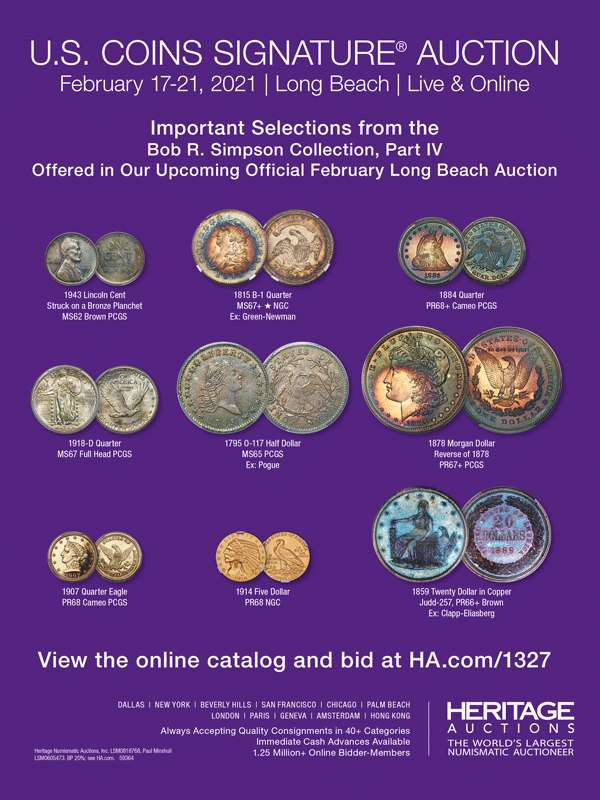
THE DARDANELLES OVERPRINTS
Dealer Pam West offered an interesting overprinted banknote in her emailed Newsletter 172 this week. It's a One Pound Dardanelles Overprint. I found some information about these on Andrew Crellin's Sterling Currency site; he in turn got some of his information from the Australian Numismatic Society website. Both articles are linked below. Here's Pam's note, followed by an excerpt from Andrew's article. -Editor
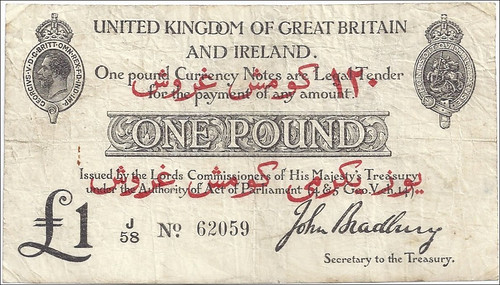
Pam West's One Pound Dardanelles Overprint
The Dardanelles Overprints are a series of British banknotes (ten shillings and one pound) over-printed in Arabic and issued for use by Allied soldiers serving at Gallipoli between May and June 1915. As there were no Allied military canteens on the Dardanelles, these notes were issued to the troops so they were able to buy items from the locals.
The "host" notes are the standard "Bradbury" one pound and ten shilling notes that were in circulation in the United Kingdom at that time.
These bank notes were only the second series of notes issued by the British Treasury, and were produced in October 1914, on specially prepared watermarked paper.
The ten shilling notes were overprinted with two lines of Arabic text, the first line reads: "Piastres silver 60", while the second line reads "Piastres silver sixty".
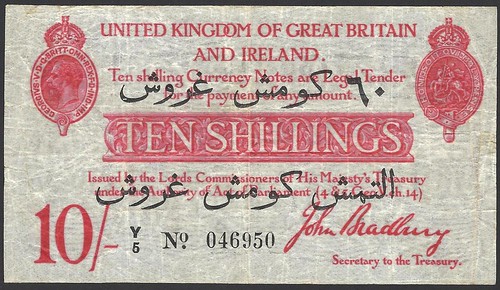
Ten Shillings Dardanelles Overprint
According to Haim Langelban, in a publication by the Association of Banknotes, Coins and Medal Collectors in Israel, the notes were issued one day after ANZAC soldiers landed in Gallipoli, (that is, from April 26, 1915).
One unforeseen complication that prevented these notes from being used actually at Gallipoli was that the Allied soldiers were actually not able to make contact with any Turkish merchants due to the slight problem of the machine guns that were in front of them!
Other anecdotal reports from Allied soldiers that served at Gallipoli state that the notes were circulated more in Palestine once the Allied soldiers had moved there.
To read the complete articles, see:
Notes made for the troops in Gallipoli
(https://www.sterlingcurrency.com.au/blog/news-research/commonwealth-banknotes/the-dardanelles-overprint-notes-real-currency-in-g/)
Mysteries of ANZAC banknotes
(http://the-ans.com/library/Gallipolibanknotes.html)
To visit Pam West's website, see:
http://britishnotes.co.uk/
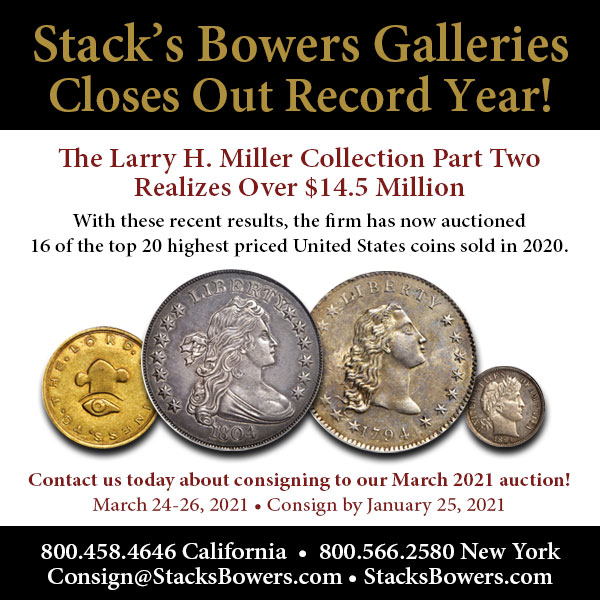
ACTF FLAGS ONLINE COIN REPLICA SELLER
This press release from the Anti-Counterfeiting Educational Foundation calls out an online seller of replica U.S. coins in violation of the Hobby Protection Act. -Editor
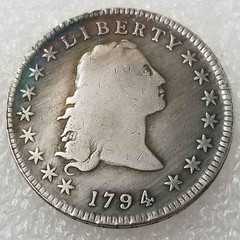
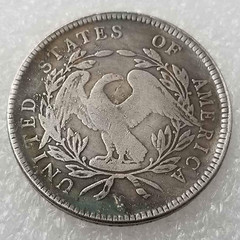
Fake 1794 Dollar obverse
Promptly acting on a tip from a concerned collector, the Anti-Counterfeiting Educational Foundation’s (www.ACEFonline.org) Anti-Counterfeiting Task Force (ACTF) has notified law enforcement agencies and online shopping platform Amazon.com about a seller who is in apparent violation of federal laws involving reproductions of rare coins.
The seller using the name SeTing offered nine reproductions of coins and fantasy dates, but none of the accompanying coin images indicated any of the items were properly marked “COPY” as mandated by the Hobby Protection Act.
The offered items included replicas of a 1794 Flowing Hair dollar, an 1804 Draped Bust dollar and a 1915 Indian Head Quarter Eagle ($5). There was also a fantasy piece resembling a Trade Dollar but with the date 1791 and a Carson City mint mark that was identified by the seller as “Old Original Morgan Dollar.” Genuine U.S. Trade Dollars were struck from 1873 to 1885 and Morgan silver dollars were produced between 1878 and 1921.
Prices for the “coins” ranged from $2.99 to $3.29 plus an additional $3.98 shipping.
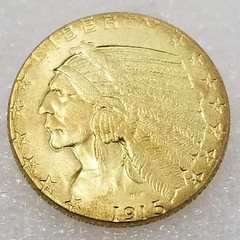
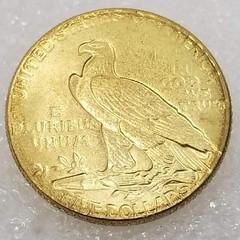
Fake 1915 Five Dollar obverse
A hobbyist who saw the online listings sent a complaint about the seller to members of the American Numismatic Association Board of Governors, some former ANA officers, the United States Mint and to several numismatic publications and numismatic information websites. ANA Past President Gary Adkins forwarded the email complaint to former Texas Police Chief Doug Davis, ACEF Director of Anti-Counterfeiting.
“The timely ‘heads up’ tip from the concerned collector is greatly appreciated. These six items are in apparent violation of both the Hobby Protection Act and Title 18 of the U.S. Code involving counterfeiting and forgery of United States coins. The task force has reported the information to the appropriate federal agencies and Amazon,” said Davis.
“ACTF currently monitors over 200 websites and social media platforms selling counterfeit coins and precious metals across the country and around the world.
Intelligence information is forwarded to the Secret Service and Treasury Department Office of the Inspector General. ACTF also assists all levels of law enforcement in counterfeit case development for prosecution,” he explained.
“The Anti-Counterfeiting Educational Foundation is aggressively seeking legislation on the state level to provide local law enforcement officers with statutes seeking criminal penalties for the possession, manufacture and distribution of counterfeit coins and precious metals,” said ACEF Executive Director Robert Brueggeman. “However, to address these problems requires the support of the numismatic community. The Anti-Counterfeiting Educational Foundation is a 501(c) (3) non-profit corporation that operates solely upon donations.”
Monetary contributions can be made online at www.acefonline.org/donate or by check mailed to ACEF, 28441 Rancho California Rd., Ste. 106, Temecula, CA 92590. For additional information about donating, contact ACEF Executive Director Brueggeman at info@ACEFonline.org.
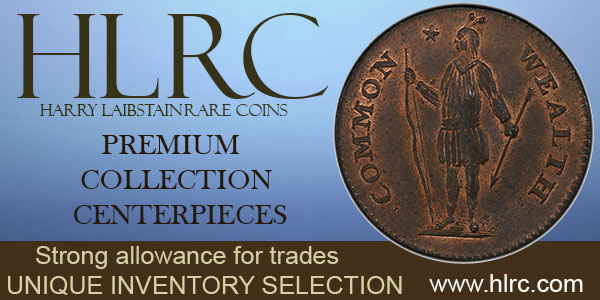
VIDEO: MAKING COINS INTO JEWELLERY
Kavan Ratnatunga passed along these videos of how coins are made into jewellery. Thanks. -Editor
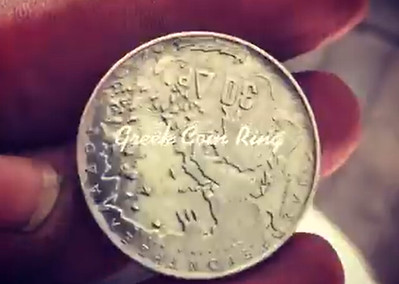
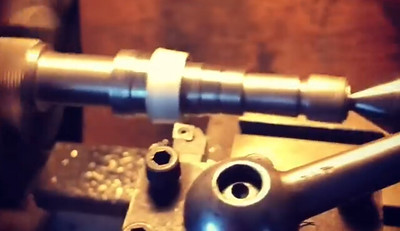
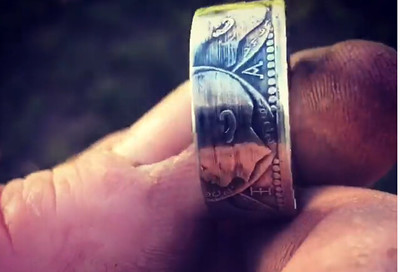
To watch the videos, see:
https://www.instagram.com/p/CJBZyXNDVPJ/?hl=en
https://www.instagram.com/thornhilljewellery/?hl=en

ALTERNATIVE CURRENCY IN THE COVID ERA
This Christmas Eve Boston Globe article discusses the alternative currency Berkshares' relevance in the COVID era, and a proposal to use the concept more widely. Here's an excerpt, but be sure to read the complete article online - it includes a great history of the Berkshares experiment and alternative currencies in general. -Editor
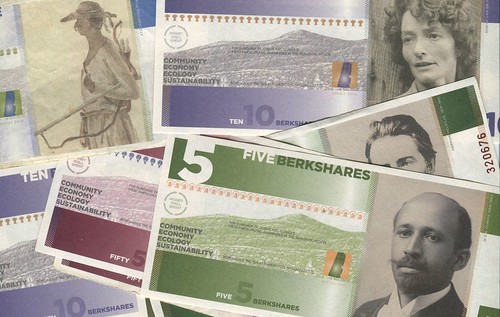
Last spring, shortly after it became clear that COVID-19 was more than just a little flu and that local shops would be down and out for more than just a little while, America got to wondering: How can we save small businesses?
Many commentators demanded quick federal relief. Some consumers went on gift card shopping sprees. And 2020 presidential candidate Andrew Yang tweeted a proposal combining the two — government-issued debit cards redeemable only at locally owned small businesses.
The Twitterati mostly condemned Yang’s idea as “stupid,” “impractical,” and “useless.” And the debit cards never came to pass; consumers got stimulus checks and small businesses got Paycheck Protection Program loans instead.
But a piece of his idea — a currency that could only be spent at local businesses — has been a fixture of life in Massachusetts’ southern Berkshires since 2006.
BerkShares, the region’s currency, are redeemable at over 400 Berkshires businesses — good for buying a pastry at the bakery or an hour of a lawyer’s time. Printed as real paper bills and adorned with hometown heroes like “The Souls of Black Folk” author W.E.B. DuBois, BerkShares can be purchased at three local banks. And for shoppers, those fancy notes are more than just a reminder to “buy local”; they’re also a way to get 5 percent off, because $95 gets you 100 BerkShares.
It wasn’t the first alternative currency in the world. It wasn’t even the first in the region. But BerkShares are arguably the most successful. In the currency’s 14 years of existence, the region has circulated $10 million worth of BerkShares, and the model has inspired other regions abroad.
Now, almost a year into America’s COVID downturn, and with roughly 800 small US businesses closing each day, politicians are trying to repair the damage. Massachusetts is investing in a “buy local”' advertising campaign. California is offering technical support to help small businesses adapt to e-commerce. But some municipal governments are looking to go further: promoting the use of a local currency by borrowing, spending, and accepting it themselves.
The idea of getting municipalities involved, which comes from the Schumacher Center for New Economics, the think tank behind BerkShares, is still in its infancy. But if it catches on — if it helps to thrust local currencies into the American mainstream — it could provide a potent new means for reviving Main Streets, whether they’re battered by a pandemic or by the relentless hammer of a globalized economy.
In recent times, US alternative currencies have been used by the private sector alone. Could American municipalities start sponsoring, accepting, and making payments with local currencies, as their European counterparts do?
In the COVID-19 pandemic’s early days, city officials in New York and New Orleans reached out to the Schumacher Center with that very question. “They were less interested in the BerkShares program as we currently run it and more interested in applying it to solving their own COVID problems,” Witt recalls.
And so, this past April, the center drafted a proposal. It outlined how municipal governments could use currencies like BerkShares to pay local vendors, and vice versa. For example, says Rachel Moriarty, the Schumacher Center’s director of operations, a town could borrow the local equivalent of BerkShares to help finance a construction project and pay workers in the local currency. The workers could also use the currency to pay at least some of their local taxes.
As a pandemic relief measure, Schumacher’s proposal also allows local governments to issue emergency local-currency payments to businesses and residents in need.
To read the complete article, see:
When money is running short, print your own
(https://www.bostonglobe.com/2020/12/24/opinion/when-money-is-running-short-print-your-own/)

VENEZUELAN RUNESCAPE GAMERS PLAY TO SURVIVE

Kavan Ratnatunga writes:
"Here's an interesting account of how the online game Runescape is helping the citizens of Venezuela survive the extended period of hyperinflation. My son has been playing this 20-year old game for many years and told me of this development."
Thanks. While non-numismatic, this is a great illustration of the versatile nature of money, the resilience of a population under great hardship, and the unexpected benefits of internet connectivity. -Editor
Venezuela used to be one of the richest countries in South America, but it has spent the last 10 years engulfed in a political and economic crisis. What started as the gradual crumbling of the country’s economy in 2010 snowballed into a devastating avalanche of crime, corruption, and mass starvation, leaving millions of people in the country unable to feed themselves or access basic medical supplies. Ninety percent of Venezuelans are now living in poverty, and one of the most extreme and sustained periods of hyperinflation ever recorded means that people working minimum wage jobs are earning the equivalent of $5 a month.
Those who remain in the country have been forced to find innovative ways to survive. While some craft bags out of worthless bolivars — Venezuelan currency — to sell at markets, others look to a virtual land of opportunity, spending hours in front of computer screens and mobile phones hunting green dragons in the online multiplayer role-playing game RuneScape.
RuneScape was originally released in 2001 by British developer Jagex, but it’s only in the last four years that a growing number of Veneuzelans have started depending on the game as their main source of income. One such player is ex-accountant Martinez, who requested that his last name not be published to protect his RuneScape account. Martinez quit his job after the inflation rate of the bolivar meant he could no longer survive on the money he was earning.
RuneScape has been a lifeline for Martinez and his entire family. He tells Polygon he earned $450 by gold farming in RuneScape, and used that money to flee Venezuela and move to Peru. He continued to play the game and saved an additional $1,000, which he used to get his mother and girlfriend out of the country.
“RuneScape is a super mainstream way to earn money in this day and age,” Martinez writes. “Depending on which state in Venezuela you are from, pretty much everyone knows about the game.”
Farming, or “gold farming,” as it’s more commonly known, involves playing a video game with the specific aim of accumulating vast amounts of in-game currency (in this case, RuneScape gold) to sell for profit outside of the game. It’s nothing new, but it has become more pronounced as Venezuela’s infrastructure has been unable to function in recent years. Every Venezuelan player we spoke to for this story told us they sell their gold for either U.S. dollars or cryptocurrencies such as bitcoin, which means that their hard work isn’t compromised by the hyperinflation of their own currency, the Venezuelan bolivar.
There’s an abundance of online websites that specialize in the buying and selling of RuneScape commodities. It’s a fiercely competitive marketplace, with several websites taking out Google Ads to appear at the top of search listings. At the time of writing, 1 million RuneScape gold sells for 63 cents.
To read the complete article, see:
How RuneScape is helping Venezuelans survive
(https://www.polygon.com/features/2020/5/27/21265613/runescape-is-helping-venezuelans-survive)

CAPE COD TREASURE HUNT'S CHEST OF SACAGAWEAS
Forrest Fenn's buried treasure soaked up all the headlines, but here's a story about a fun local hunt organized in Cape Cod. -Editor
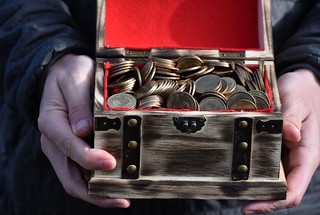 At noon Friday, Chris Doyle stood on Wing Island in Brewster surrounded by hundreds of footprints, a dozen shallow holes, and sadly, a discarded coffee cup — remnants of the treasure hunters who came before him.
At noon Friday, Chris Doyle stood on Wing Island in Brewster surrounded by hundreds of footprints, a dozen shallow holes, and sadly, a discarded coffee cup — remnants of the treasure hunters who came before him.
Within hours, Doyle and his friend Jack Bicker, both 28-year-old Brewster residents and outdoor enthusiasts, had found it — a treasure chest that was exchanged for 500 golden-hued Sacagawea coins and an equal donation to Wild Care in Eastham, the charity of their choice.
“We buried the treasure a week ago and posted on Facebook Dec. 12,” the hunt’s co-creator Jordan Fowler, 27, said. “We thought maybe we’d get five or 10 people but the whole thing blew up.”
Fowler picked up hundreds of Facebook friends and nearly 200 shares about the hunt, a story in the Cape Cod Times and broadcasts on two radio stations. Treasure hunters dug up Fowler’s phone number and called day and night with questions.
The treasure map, so to speak, was a riddle written by the hunt’s co-planner Aaron Lynn, author of the Troika fantasy trilogy, who grew up in Brewster.
The plan to bury a treasure chest was hatched on Thanksgiving day because Fowler and Lynn wanted to give back to the community where they had so happily grown up.
As for their own treasure, paid in gold-colored dollar coins, Doyle said he is keeping it.
“I can’t see ever spending it,” Doyle said. “I want to keep it so we can sit around and have a laugh about the time we actually found buried treasure.”
To read the complete article, see:
Riddle solved, Cape Cod buried treasure found on Brewster island
(https://www.capecodtimes.com/story/news/2020/12/20/cape-cod-treasure-found-brewster-boys-500-goes-wild-care/3976649001/)
To read the earlier E-Sylum article, see:
FORREST FENN FORTUNE FINDER FOUND
(https://www.coinbooks.org/v23/esylum_v23n50a32.html)

FEATURED WEB SITE: VICTOR HUSTER MINT
This week's Featured Web Site is the Victor Huster Medal Cabinet and Mint.

http://victor-huster.de/>


